
www.kentuckymonthly.com DISPLAY UNTIL 04/11/2023 MARCH 2023 with Kentucky Explorer +MORE The History and Beauty of Wickliffe Mounds Shades of Compassion Exhibit The Café at Swope Toyota SOUTHERN KENTUCKY BOOK FEST KEN TU CK Y’S NATURAL ARCHES



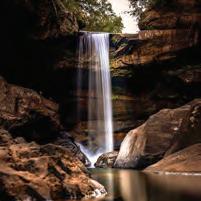


This material is based upon work supported under a grant by the Appalachian Regional Commission. Any opinions, findings and conclusions or recommendations expressed in the material are solely the responsibility of the authors and do not necessarily represent the official views of the Appalachian Regional Commission. Explore All the Falls on The Kentucky Wildlands Waterfall Trail: exploreKYwildlands.com or scan
In The Kentucky Wildlands, you’ll find many paths that lead through pristine ancient forests and over mountains rewarding you with spectacular natural wonders, such as the ones on The Kentucky Wildlands Waterfall Trail. VANHOOK FALLS
how the rushing water makes you do the opposite. ANGLIN FALLS
1.7 mile trail
Photo: Steve Poynter
Amazing
Access:
Robinson EAGLE FALLS Access: 1.5 mile trail
Photo:
Dustin
Poynter CREATION FALLS Access: 1.4 mile trail
Photo: Steve
Hendrickson 76 FALLS Access: short walk or by boat
Photo: Rodney
Photo: Jim
Ledford
16 Geological Gems Eastern Kentucky teems with a treasure trove of natural arches
26 Ancient Culture and Natural Beauty Wickliffe Mounds State Historic Site offers prehistoric artifacts and stellar scenery in one spot
29 Southern Kentucky Book Fest A complete listing of the festival’s panels, workshops, presentations and authors scheduled to appear
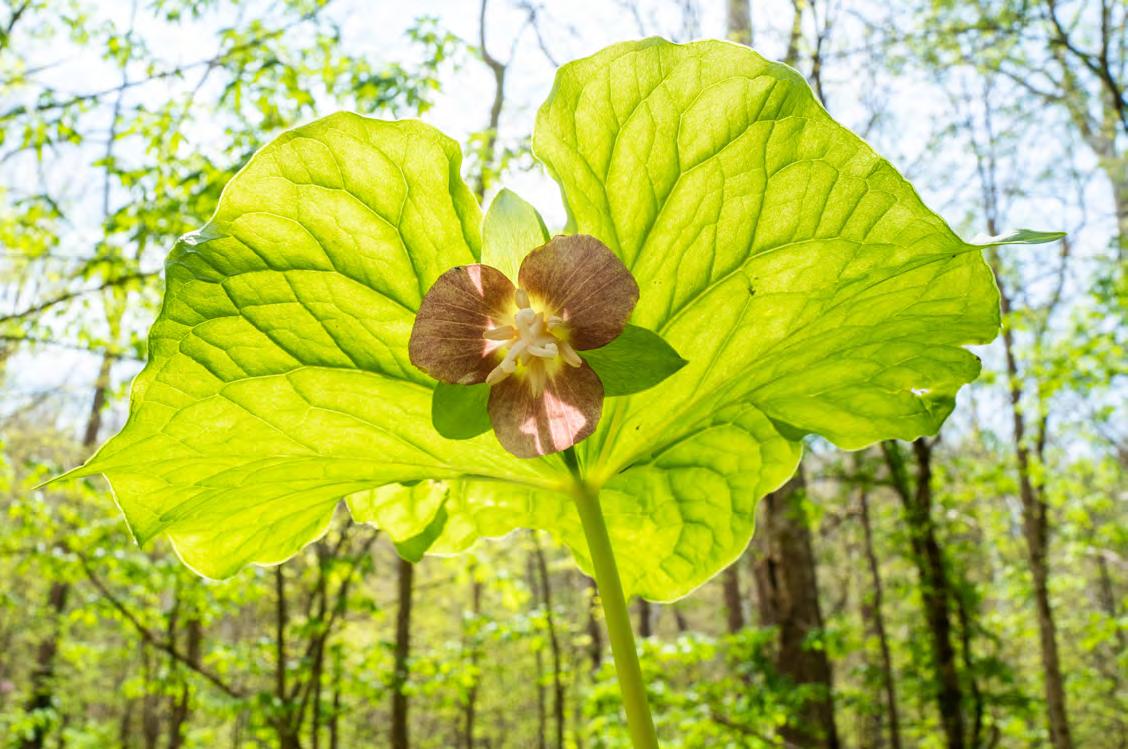
38 Images and Emotions A traveling photography exhibit uses positive images to motivate viewers to feel compassion and take action
44 Hidden Treasure The Café at Swope Toyota is a delightful, delicious surprise tucked away in a car dealership

DEPARTMENTS
Kentucky
3 Readers Write 4 Mag on the Move 11 Music 12 Cooking 47 Kentucky Explorer 58 Past Tense/ Present Tense 59 Off the Shelf 60 Gardening 62 Field Notes 63 Calendar 64 Vested Interest
2
Kwiz
kentuckymonthly.com 1 in this issue 38
12
ON THE COVER
Suzanna’s Arch at Cliffview Resort in Wolfe County; photo by John Stephen Hockensmith
MARCH
kentucky kwiz
Test your knowledge of our beloved Commonwealth. To find out how you fared, see the bottom of Vested Interest.
1. ESPN anchor Michael Eaves, born and raised in Hopkins County, was the first what?
A. University of Kentucky graduate to become a sports broadcaster
B. Black athlete to compete in the Kentucky High School Athletic Association (KHSAA) golf tournament
C. Spokesman for LeafFilter®
2. Which two Lexington high schools have the highest number of KHSAA boys’ state basketball championships with six each?
A. Dunbar and Tates Creek
B. Tates Creek and Lexington Catholic
C. Henry Clay and Lafayette
3. Which high school has the highest number of KHSAA girls’ state basketball championships with six?
A. Sacred Heart Academy
B. Laurel County
C. Ashland Blazer
4. The Honorable Order of Kentucky Colonels traces its beginning to the commissioning of which pioneer by Judge Richard Henderson of the Transylvania Company?
A. Daniel Boone
B. Simon Kenton
C. James Harrod
5. Renfro Valley and the Kentucky Music Hall of Fame are built around the horse stables of which music icon?
A. Bill Monroe
B. Jack Harlow
C. John Lair
6. The award-winning Kentucky Crafted: The Market, scheduled for March 11-12 in Lexington, was launched 38 years ago by which Kentucky governor?
A. John Y. Brown Jr.
B. Martha Layne Collins
C. Paul Patton
7. On March 5, 1964, the Rev. Dr. Martin Luther King Jr. was joined by 10,000 people in a march to the State Capitol to demonstrate against segregation and discrimination in Kentucky. Which Baseball Hall of Famer participated in the march?
A. Satchel Paige
B. Hank Aaron
C. Jackie Robinson
8. Eskippakithiki, the last Shawnee village in Kentucky with a population of 1,800, was in which central Kentucky county?
A. Madison
B. Estill
C. Clark
9. During the 1950s, Kentucky lost 13 percent of its population, as depicted in the song “Readin’, Rightin’, Route 23” by which Country Music Highway artist?
A. Dwight Yoakam
B. Loretta Lynn
C. Patty Loveless
10. Fort Thomas’ Lucien Hubbard was the first winner of which award in 1927?
A. Academy Award for Best Picture
B. Pulitzer Prize for Feature Writing
C. Nobel Prize in Physics
Celebrating the best of our Commonwealth
© 2023, Vested Interest Publications
Volume Twenty-Six, Issue 2, March 2023
Stephen M. Vest
Publisher + Editor-in-Chief
Editorial
Patricia Ranft Associate Editor

Rebecca Redding Creative Director
Deborah Kohl Kremer Assistant Editor
Ted Sloan
Contributing Editor
Cait A. Smith Copy Editor
Senior Kentributors
Jackie Hollenkamp Bentley, Jack Brammer, Bill Ellis, Steve Flairty, Gary Garth, Mick Jeffries, Kim Kobersmith, Brigitte Prather, Walt Reichert, Tracey Teo, Janine Washle and Gary P. West
Business and Circulation
Barbara Kay Vest Business Manager
Jocelyn Roper Circulation Specialist
Advertising
Lindsey Collins Senior Account Executive and Coordinator
Kelley Burchell Account Executive
Teresa Revlett Account Executive
For advertising information, call 888.329.0053 or 502.227.0053
KENTUCKY MONTHLY (ISSN 1542-0507) is published 10 times per year (monthly with combined December/ January and June/July issues) for $25 per year by Vested Interest Publications, Inc., 100 Consumer Lane, Frankfort, KY 40601. Periodicals Postage Paid at Frankfort, KY and at additional mailing offices.
POSTMASTER: Send address changes to KENTUCKY MONTHLY, P.O. Box 559, Frankfort, KY 40602-0559.


Vested Interest Publications: Stephen M. Vest, president; Patricia Ranft, vice president; Barbara Kay Vest, secretary/treasurer. Board of directors: James W. Adams Jr., Dr. Gene Burch, Gregory N. Carnes, Barbara and Pete Chiericozzi, Kellee Dicks, Maj. Jack E. Dixon, Bruce and Peggy Dungan, Mary and Michael Embry, Judy M. Harris, Greg and Carrie Hawkins, Jan and John Higginbotham, Frank Martin, Bill Noel, Michelle Jenson McDonnell, Walter B. Norris, Kasia Pater, Dr. Mary Jo Ratliff, Barry A. Royalty, Randy and Rebecca Sandell, Kendall Carr Shelton and Ted M. Sloan.
Kentucky Monthly invites queries but accepts no responsibility for unsolicited material; submissions will not be returned.
kentuckymonthly.com

2 KENTUCKY MONTHLY MARCH 2023
Readers Write
Subscribers Weigh in on ‘E’ vs. ‘e’
I’m glad Gayle Deaton cares (February issue, page 64). Bless her, her family and those who’ve had such a difficult time with flooding in the eastern part of our state. Eastern Kentucky deserves an “E” not out of sympathy or because it’s the first word of this sentence, but it is an adjective describing a proper noun. If that’s not a grammatical rule in the English language, then we need to declare it so. Her examples are well stated. You and I are Central Kentuckians. Let’s modify Kentucky properly with a capitalized Eastern.
John D. Stewart, Lexington
• • •
I vote for “E.” I was taught to capitalize specific geographical areas. I concede this can cause confusion in some cases, such as John Denver’s song, “Country Roads,” where, I’m told, he’s actually singing about the region
“West” Virginia (a region in the state of Virginia) not the state of West Virginia. Anyway, the state of West Virginia has claimed the song as its own.
As for your example of Whitley County not being in Eastern Kentucky, I grew up in Corbin, and when someone asks where I grew up, I say, “Corbin, in Southeastern Kentucky.”
Hank Triplett, Ph.D., Louisville
• • •
Lol. I disagree but then I am from Louisville and Nelson County, and we deserve the capitalizations! :) I would use a small e.
(Hank’s wife) Ann E. Triplett (RN, BSN, MSN with editing experience and a minor in English)
• • •
I vote for little e. Eastern Kentucky is not a specific city or town; it is a region. Some folks may relate to a different area, and some believe they are in eastern Kentucky.
I live in the south end of Louisville—the Beachmont neighborhood. I believe that western, central or northern Kentucky are just geographic regions—areas where they can describe their place in the Commonwealth.
Thomas H. Harris, Louisville
The Literary Issue
We—Gail and I—enjoyed the February issue, focusing in many ways on Kentucky writers. It was, I thought, insightful and a lot of fun to read.

The story about Ada Limón focused appropriately on her Kentucky connections and her love of the state. I enjoyed finding out more about her. I also wondered if it might have been possible to include part or all of one of her poems— unless I missed it, always a possibility.
Thank you again for a great issue.
Dick Kaukas, Louisville
The Kentucky Gift Guide Drink Local

Counties mentioned in this issue... kentuckymonthly.com 3
UNITING KENTUCKIANS EVERYWHERE. We Love to Hear from You! Kentucky Monthly welcomes letters from all readers. Email us your comments at editor@kentuckymonthly.com, send a letter through our website at kentuckymonthly.com, or message us on Facebook. Letters may be edited for clarification and brevity.
Find more at kentuckymonthly.com. Use your phone to scan this QR code and visit our website. Follow us @kymonthly This handy guide to sipping in the Bluegrass State spotlights local breweries, wineries and, of course, distilleries. Discover unique ways to drink in Kentucky, creative cocktail recipes and more.
Monthly’s annual gift guide highlights some of the finest handcrafted gifts and treats our Commonwealth has to offer.
Kentucky
MAG ON THE MOVE
Even when you’re far away, you can take the spirit of your Kentucky home with you. And when you do, we want to see it!
Baltic Sea Cruise SWEDEN + LITHUANIA
Greg and Keiren Gillum of Richmond sailed the Baltic Sea and are pictured in Stockholm, Sweden (above), and in front of the Meridian sailing ship in Klaipeda, Lithuania (right). The couple also visited Latvia.

Scan the QR code to upload a photo, or email a high-resolution photo, along with a caption to editor@kentuckymonthly.com
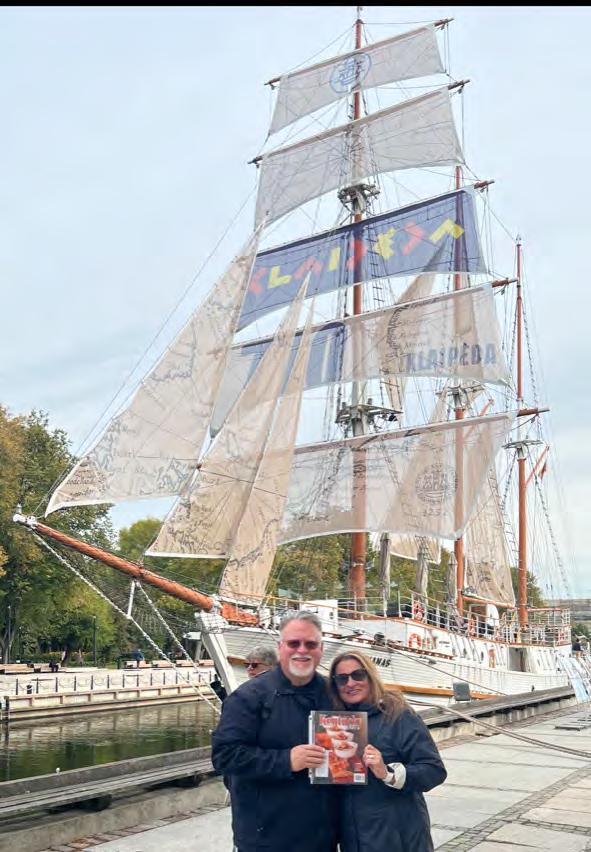
4 KENTUCKY MONTHLY MARCH 2023
travel
SUBMIT A PHOTO
Explore infinite possibilities.
Experience high school differently. The Gatton Academy of Mathematics and Science offers gifted and talented high school juniors and seniors in Kentucky a chance to start college while finishing high school at Western Kentucky University. This two-year residential STEM program allows students to participate in college coursework full-time, pursue faculty-mentored research, study abroad, and thrive in a supportive community. With scholarships covering tuition, housing, and meals, students at Gatton can explore their interests in STEM. Explore your infinite possibilities at www.wku.edu/academy.
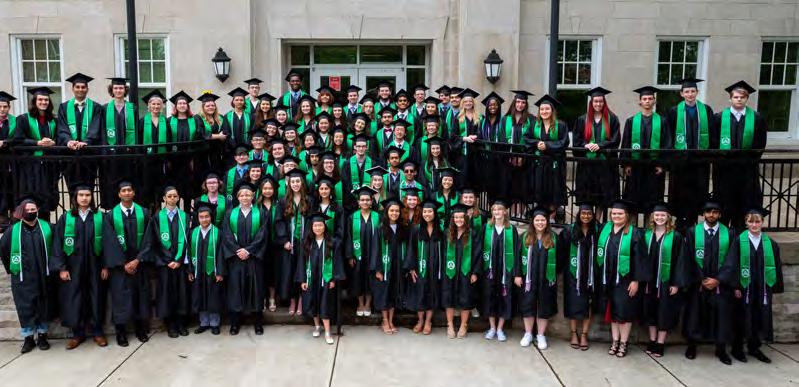




270.745.6565 academy@wku.edu @gattonacademy
wku.edu/academy
Adventures Abroad
HAWAII ( top )
Stew and Linda Wade of Greenville traveled to Hawaii, where they are pictured atop Diamond Head with children and grandchildren Leah, Ray and Reese Ippolito of Bethesda, Maryland; Adam, Beth Morgan, Sasha and Maya Wade of Danville; and Erica, Josh, Lincoln and Elliot Richardson of Louisville.
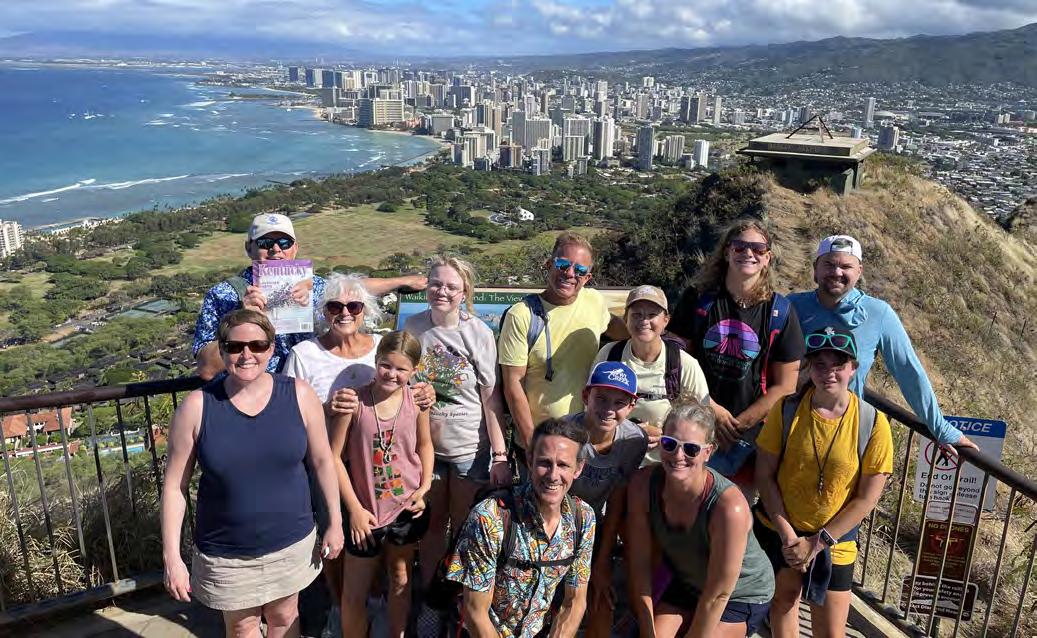
ALASKA ( left )
Harrodsburg residents Lee and Debbie Gresham and Ray and Susan Assmar of Owensboro sailed a chartered vessel at South Sawyer Glacier in Alaska.

WALES ( above )
Gay Vekovius, formerly of Louisville now living in Nashville with her husband, Al, in Wales beside their narrowboat, which they crewed through the Brecon Canal. Their friends Dick and Katharine Jefferts Schori crewed their own boat for a week of lovely companionship.
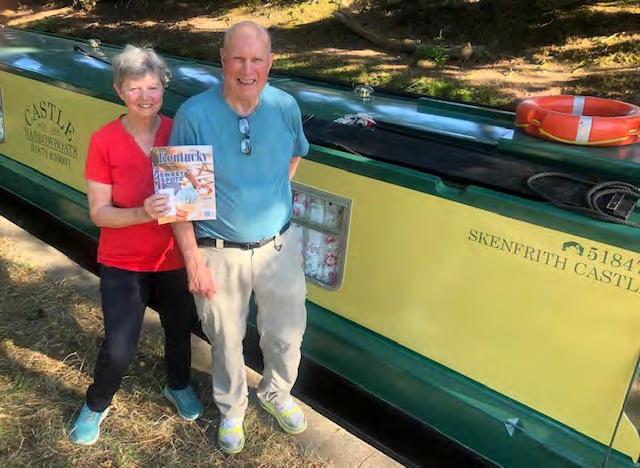
6 KENTUCKY MONTHLY MARCH 2023
The Far East SINGAPORE




Glenn and Tina Gail of Crestwood enjoyed traveling to Bali, Indonesia. On the return trip, they spent three days in Singapore, where this photo was snapped.


Flowers Galore MICHIGAN
Sharon Guenthner and James Smith of Louisville took in the Tulip Festival in Holland, the scenic town in Michigan not to be confused with the European country.

kentuckymonthly.com 7 Through June 3 Sponsored by DOWNTOWN PADUCAH, KY QUILTMUSEUM.ORG SPOTTSVILLE Boucherie Vineyards & Winery boucheriewinery.com 270.826.6192 RICHMOND Chenault Vineyards chenaultvineyards.com 859.328.7773 ROBARDS Farmer & Frenchman Winery farmerandfrenchman.com 270.748.1856 PADUCAH Purple Toad Winery purpletoadwinery.com 270.554.0010 BLOOMFIELD Springhill Plantation Bed & Breakfast & Winery www.springhillwinery.com 502.252.9463 Kentucky Wineries may we recommend... Talon Winery 7086 Tates Creek Road Lexington, KY 40515 talonwine.com 859.971.3214
Balloon Rides, Reunion Travels and More CALIFORNIA, TETON VALLEY + BELIZE
Jill Smith of Bowling Green and Allen Dossey of Paducah delighted in a ballon ride over the Napa, California, vineyards. Above,

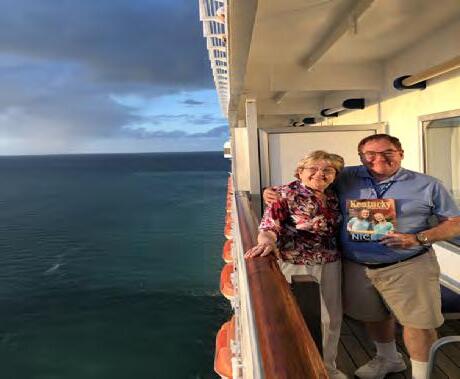
of Louisville’s Seneca High School Class of 1968 traveled to the Teton Valley in Idaho and Wyoming. From
Tom Webb (Dublin, Ohio), Marilyn Harvin Harkrider (Houston), Margaret Ann Barnes Pennington (Louisville), Becky Barrier Nelson (Georgetown), Glenn Baron (Waxhaw, North Caolina), Michelle Klein Ruby (Louisville) and Marty Ruby (Louisville).
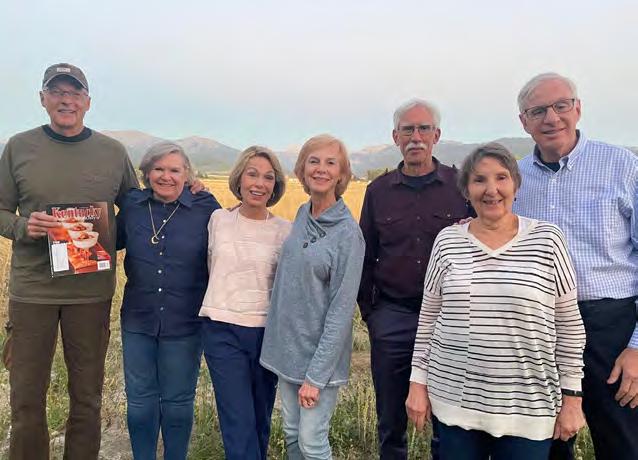
8 KENTUCKY MONTHLY MARCH 2023
Top,
left, members
left,
Above right, Joan and Nick Butcher of Smiths Grove enjoyed a relaxing cruise and are pictured onboard the ship, just off the coast of Belize.


kentuckymonthly.com 9 attention,
Kentucky Monthly's annual recipe contest is back following a pandemic-induced hiatus. Submit your favorite original recipe for a chance to win great prizes and see your dish featured in our May issue. SUBMIT YOUR RECIPE AT KENTUCKYMONTHLY.COM SUBMISSIONS DUE MARCH 13 ENTER KENTUCKY MONTHLY'S RECIPE CONTEST!
home chefs...
Desert Journeys and Scenic Trails

THE HOLY LAND, EGYPT AND THE NORTHWEST
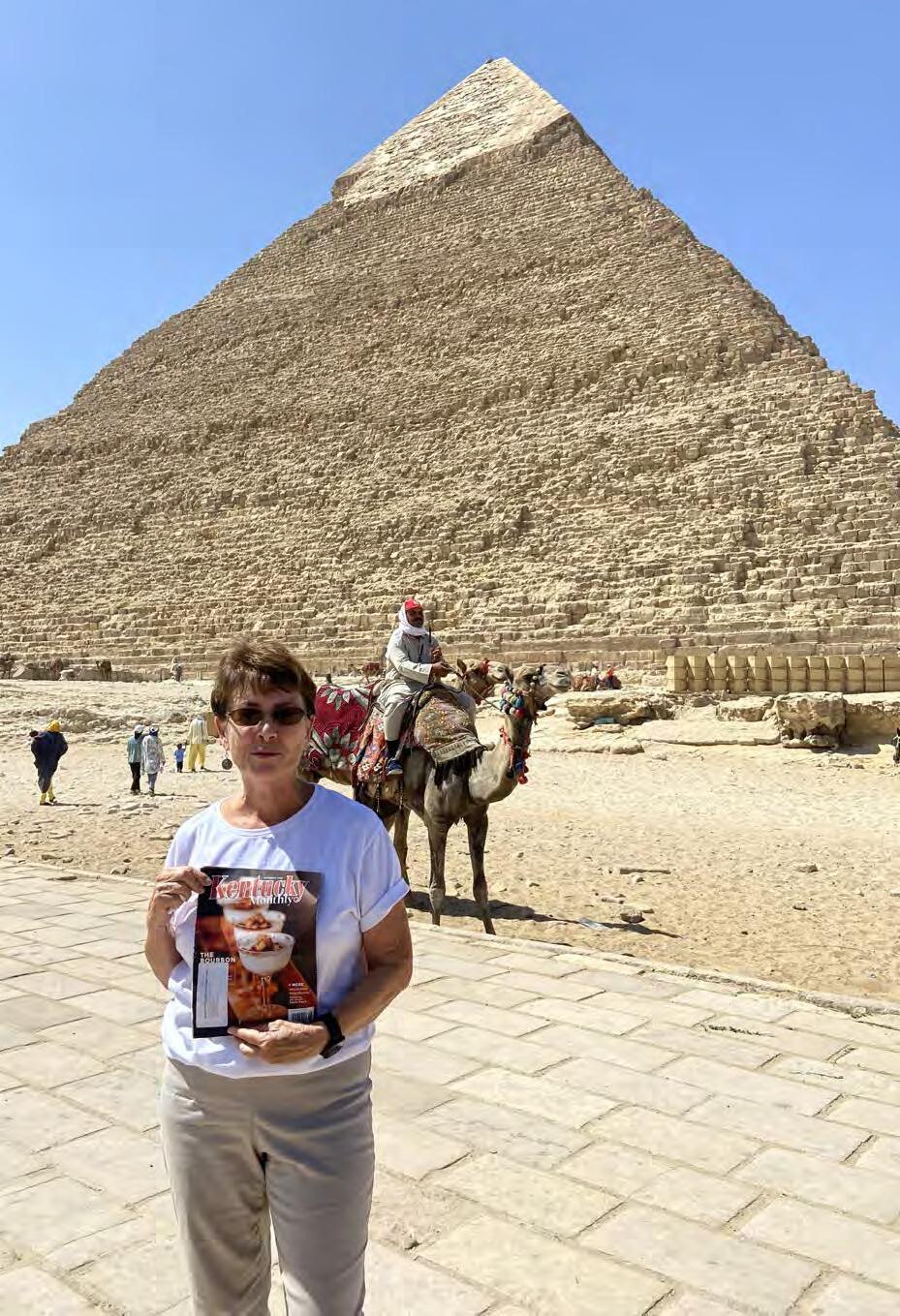
Top, Lexington-area friends enjoyed a cruise and visits to “Lands of the Bible” around the Mediterranean Sea. Gathered at the Shepherds Field in Bethlehem were, from left, Bill and Joyce McKinney Mike and Sherry Powers Helen Rhea Stumbo Bob and Jackie Duncan, Scott and Michelle Stewart, and Bill and Susan Arnold. Left, Louisville’s Mary Schenkenfelder marveled at the wonder that is the Great Pyramid of Giza in Egypt. Above, Amy and John Davenport of Louisville took in the sights while hiking the Trail of Ten Falls in Oregon’s Silver Falls State Park.

10 KENTUCKY MONTHLY MARCH 2023
The Yodeling Cowgirl
The title of Phoebe White’s first album, Unexpected, is an accurate one. Phoebe is a 13-year-old homeschooled African-American girl from London who can yodel like a Patsy Montana dream.
Charming and lighthearted, Phoebe explained that listening to LeAnn Rimes’ first hit “Blue” changed her life. She loved the yodeling part and played the song over and over, imitating Rimes’ yodel until she had it down.
Phoebe was only 7 at the time, but she knew she’d found a musical style that spoke to her. She started performing early. “When I first sang in front of people, I liked it, and I asked my mother to find places for me to sing,” she said. “I was 7 years old when I won my first contest at Renfro Valley.”
Her mother, Tiffany, explained that it was an open talent show that anyone could enter, and Phoebe won.
Tiffany is far from a stereotypical stage mother. Her homeschooling of Phoebe provides flexibility in their travel schedule. Phoebe refers to her mother as her “momager.”
One of the things Tiffany appreciates about her daughter’s musical taste is that the songs she prefers are age appropriate. Many Western-style songs involve cheating or drinking or broken hearts. Phoebe has her mother research songs for her, and Tiffany said she’s discovered that the older the song, the more her daughter likes it.
Considering Phoebe’s youth, the pair often work together on stage wear. That often means buying clothes off the rack and adding sequins and fringe. Phoebe has a fondness for what she refers to as “sparkly stuff.”
All things Country and Western appeal to Phoebe. She is a big fan of Roy Rogers and Dale Evans and likes to listen to their music and watch their movies.
She found “her people” when she and Tiffany attended the International Western Music Association Conference in Albuquerque last November. Phoebe reveled in being surrounded by others who love Western music and Western motifs as much as she does. “It was so nice. They are the nicest people on the planet,” Phoebe said.
The pair sent an audition video to WoodSongs Old-Time Radio Show, which originates from Lexington. The show’s host, singer-songwriter Michael Johnathon, was so impressed he asked Phoebe to perform on the 1,000th WoodSongs show, where she opened for the renowned cowboy singing group Riders in the Sky.
It was a dream come true. Tiffany said that Phoebe’s music idols were gracious and kind. “They’re so genuine— such fantastic people,” she said. In fact, Woody Paul, the band’s fiddle player, has stayed in touch, and he and Phoebe used Zoom to have “jam sessions during the pandemic,” Tiffany said. Paul has taken Phoebe backstage at the Grand Ole Opry in Nashville and has introduced her to management there.
The admiration is mutual. Riders in the Sky tweaked a movie classic, “Jessie, the Yodeling Cowgirl” from Toy Story 2. The result, “Phoebe, the Yodeling Cowgirl,” is one of the tracks the group sings on Phoebe’s debut release. Johnathon showed his faith in Phoebe’s talent by co-producing the album, and the renowned McLain Family Band also played on the album. Phoebe’s performance schedule happens organically. “I don’t have to go knocking on doors. Opportunities come. It’s a God thing,” Tiffany said. Pre-pandemic, Phoebe was playing 70-75 shows a year, but that slowed down during the shutdown. Her playing days are ramping back up as the music world ramps up, with COVID restrictions being eased. She often plays at festivals, and this summer, she’ll play at the Master Musicians Festival in Somerset in July, where fellow Kentuckian Wynonna Judd will headline.
Phoebe is well versed in famous Kentucky singers and appreciates the work of fellow Kentuckians Loretta Lynn, Exile, Steve Wariner, Steven Curtis Chapman and the Judds. While Phoebe likes music from the 1970s, ’80s and ’90s, her heart belongs to the acoustic world of Western music.
Although she has an album out and has been backstage at the Opry, Phoebe remains a typical 13-year-old in many ways. She likes playing volleyball and is on a swim team. She struggles with her science classes, enjoys painting and is learning to play banjo.
Unlike most kids her age, though, she has professional goals. She’d like to play onstage at the Grand Ole Opry, begin writing her own songs, and make another album. Her reason for performing is simple: “I like making people happy and smile.”
To keep up with Phoebe, check out her website at singphoebesing.com. The site includes a link to her Facebook page, where dates for her performances are posted.
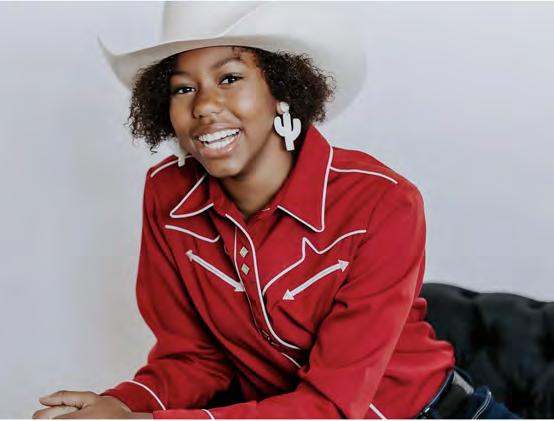
by Laura Younkin music kentuckymonthly.com 11
From Pitchfork to dinner fork
Maggie Keith and Lindsey McClave , the hosts of KET’s The Farmer & The Foodie , travel the Commonwealth and visit with Kentucky farmers to learn how their food is grown. The duo then take what they’ve learned into the kitchen to prepare a delicious feast for their guests.
On the program’s third season, which premiered in January, Maggie (the farmer) and Lindsey (the foodie) visit Lexington’s Slak Market Farm to make dishes with labneh, a cheese with Middle Eastern roots; learn about draft animals at a Henry County farm and whip up a potato gratin; explore heirloom seeds from a Jackson County farm and prepare a Sunday roast; and tour Maker’s Mark Distillery to learn about the American white oak used in bourbon barrels before mixing a Paper Plane Cocktail.

12 KENTUCKY MONTHLY MARCH 2023 cooking
Cheesecake with Honeyed Blueberries
Crust
1½ cups almond flour
¼ cup brown sugar
4 tablespoons unsalted butter, melted
Filling
1 cup fresh labneh
1/3 cup sugar
1 egg
2 tablespoons unsalted butter, melted
¼ cup sour cream
¼ cup almond flour
1 teaspoon vanilla extract
1 teaspoon lemon zest
1 teaspoon lemon juice
¼ teaspoon salt
Honeyed Blueberry Topping
1 tablespoon sugar
1 tablespoon honey
Pinch of salt
1 cup fresh blueberries
Fresh mint leaves, for garnish
Crust
1. Preheat oven to 350 degrees.
2. Combine almond flour, brown sugar and butter in a small bowl, stirring well.
3. Press mixture into the bottom of a 10-inch springform pan and bake for 8 minutes.
4. Remove from oven and allow to cool at least 30 minutes before adding filling.
Filling
1. Preheat the oven to 350 degrees.
2. Place all the filling ingredients into the bowl of a food processor and purée until smooth and creamy.
3. Pour mixture into the cooled pie crust and bake for 30 minutes. Remove from the oven and allow to cool completely, or overnight, before removing the springform pan sides.
Topping
1. Just before serving, combine the sugar, honey and salt in a small saucepan and heat over medium low.
2. As soon as the sugar and honey have dissolved, add the blueberries. Continue to cook over medium-low heat for five minutes, stirring frequently.
3. Remove from heat and allow to stand an additional five minutes until the mixture thickens slightly.
4. Spoon the blueberries over the top of the cheesecake and drizzle with extra honey sauce.
5. Garnish with fresh mint leaves, slice and serve.
Labneh with Balsamic Roasted Grapes
SERVES 4 AS AN APPETIZER
1½ cups red seedless grapes
1 tablespoon balsamic vinegar, plus additional for garnish
1 tablespoon olive oil, plus additional for garnish
¼ teaspoon kosher salt
1/8 teaspoon black pepper, plus additional for garnish
1 cup labneh
¼ cup pistachios, crushed Maldon salt, for garnish
Fresh thyme leaves, for garnish
Celery stalks and pita bread or pita chips for serving
1. Preheat oven to 400 degrees.
2. Toss grapes with balsamic vinegar, olive oil, kosher salt and pepper and place on a rimmed sheet pan. Roast for 20 minutes until the grapes have begun to shrivel and brown slightly.
3. Scatter grapes over a bed of labneh and garnish with crushed pistachios, balsamic vinegar, olive oil, thyme, Maldon salt and black pepper.
4. Serve with celery stalks and pita bread or pita chips.

kentuckymonthly.com 13
8
SERVES
RECIPE COURTESY OF KENYA ABRAHAM, SLAK MARKET FARM
Pumpkin and Potato Gratin

SERVES 8
3 cups cream
2 cloves garlic, grated
1 tablespoon grated onion
1 inch fresh ginger root, peeled and grated
Pinch of nutmeg
1 sprig fresh rosemary
4 sprigs fresh thyme
½ teaspoon kosher salt, plus additional to taste
¼ teaspoon black pepper, plus additional to taste
1 medium baking pumpkin, such as Long Island Cheese
6 medium Yukon gold potatoes, peeled
1 cup freshly grated parmesan cheese, plus extra for topping
1. Preheat oven to 350 degrees.
2. Pour cream into a small pot and place over medium-low heat. Warm cream until hot but just shy of simmering.
3. Remove from heat and stir garlic, onion, ginger, nutmeg, rosemary,
thyme, ½ teaspoon salt and ¼ teaspoon pepper into cream. Cover and allow cream to steep with the aromatics while you prepare the pumpkin and potatoes.
4. To break down the pumpkin, begin by slicing off a thin piece along one side, creating a flat surface. Turn the pumpkin onto that flat surface and slice off a thin layer of the bottom of the pumpkin, making another flat surface on the base of the pumpkin. Trim off the skin of the pumpkin, removing from all sides, and then cut the pumpkin in half, scooping out and discarding the seeds, removing as much pulp as possible.
5. Slice each pumpkin half into three equal-sized pieces that are manageable to grasp and will make it easy to thinly slice. Using a mandoline or a knife, slice both the pumpkin and the potatoes as thinly as possible, around 1/8 -inch thick. The shape of each slice may vary slightly, but most importantly, the slices of potato and the pumpkin are of equal thickness, so they cook evenly.
6. Cover the base of a 9- by 13-inch casserole dish with a layer of potato or a layer of pumpkin, or a mix of both. Feel free to get creative with your design here; the most important part is to make sure each layer is full, leaving as few holes or open areas as possible.

7. After the first layer is in place, sprinkle with 2 tablespoons parmesan cheese, a pinch of salt and a pinch of pepper. Continue layering the potato and pumpkin, seasoning each layer with parmesan, salt and pepper, until all the vegetables are gone.
8. Remove the rosemary and thyme from cream and carefully pour cream over the entire casserole. Finish with a generous shower of parmesan cheese and sprinkling of fresh thyme leaves.
9. Bake, uncovered, for about one hour, until a knife slides easily through the center of the casserole and the top is browned and bubbly.
10. Allow to sit for 10 minutes before serving.
14 KENTUCKY MONTHLY MARCH 2023 cooking
The Farmer and The Foodie: Maggie Keith, left, and Lindsey McClave
Sunday Roast
SERVES 6
3-4 pounds chuck roast
Kosher salt, to taste
Black pepper, to taste
Neutral oil such as grapeseed
1 cup chopped onion
¾ cup chopped celery
¾ cup chopped carrots
3 cloves garlic, chopped
½ teaspoon red pepper flakes
2 tablespoons tomato paste
1 28-ounce can whole peeled tomatoes with juice (crush tomatoes with your hands)
2 cups dry red wine
2 cups unsalted beef stock
8 sprigs fresh thyme
2 sprigs fresh rosemary
1 large bunch spinach
¼ cup minced parsley
1. Preheat oven to 325 degrees.
2. Remove roast from fridge 30 minutes to 1 hour before cooking, allowing it to reach room temperature. Pat roast dry and season liberally on all sides with salt and pepper.
3. Warm Dutch oven over mediumhigh heat and add oil. Once oil is
Paper Plane
Cocktail
shimmering, add roast and sear, cooking on all sides until brown, 2-3 minutes per side. Remove roast, leaving drippings in the pan, and set aside.
4. Reduce heat to medium and cool a bit before adding onion, celery and carrots to meat drippings. Sauté until veggies begin to soften, about 10 minutes, adding the garlic and red pepper flakes halfway through.
5. Once veggies become translucent, add tomato paste and stir to combine. Add crushed tomatoes and juice, along with wine and stock. Stir well and bring to a boil.
6. Return roast to the pot and top with thyme and rosemary. Cover and transfer pot to the oven.
7. Cook 2½ hours, until roast is tender and beginning to fall apart.
8. Remove pot from the oven and transfer roast to a plate.
9. Place pot and sauce over medium heat and bring to a simmer, allowing sauce to reduce for an additional 15 minutes. While sauce is simmering, use two forks to shred roast into large pieces.
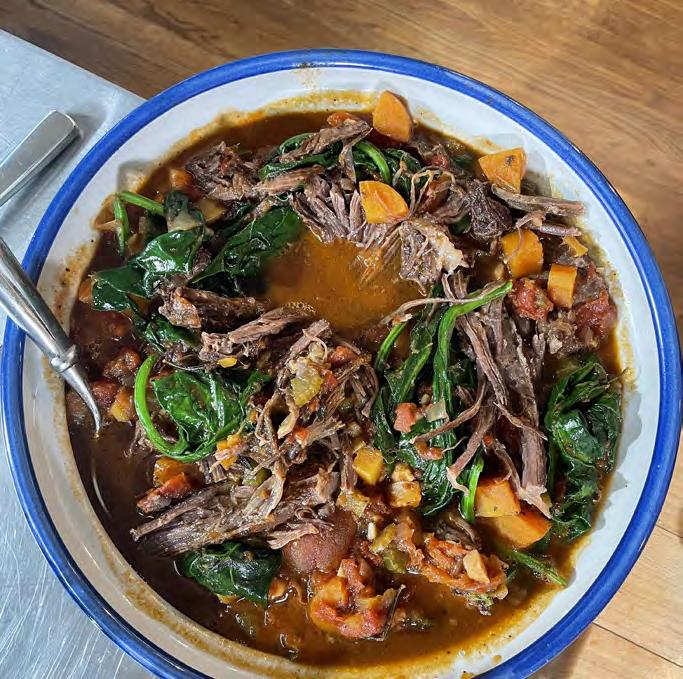
10. Add spinach to pot and stir until wilted. Return shredded roast to the pot and stir to combine.
11. Garnish with parsley and serve.
MAKES 2 COCKTAILS
2 ounces bourbon
2 ounces Aperol
2 ounces amaro
2 ounces freshly squeezed lemon juice
2 lemon twists, for garnish Ice, for mixing
1. Fill two coupe glasses with ice cubes and set aside.
2. Fill a cocktail shaker with ice and add bourbon, Aperol, amaro and lemon juice. Shake vigorously until the outside of the shaker becomes very cold.

3. Remove ice cubes from coupe glasses and strain cocktail into each coupe.
4. Garnish with lemon twist and serve.
Recipes and photos provided by The Farmer & The Foodie, which airs Saturdays at 3:30 p.m. ET on KET. For more recipes, visit KET.org/Farmer&Foodie.
kentuckymonthly.com 15

GEOLOGICAL GEMS
Eastern Kentucky teems with a treasure trove of natural arches
BY KIM KOBERSMITH
kentuckymonthly.com 17
Split Bow Arch (Bill Fultz photo)
Deep in the narrow, sinewy, flat-topped forested ridges of eastern Kentucky, often hidden in the winding gorges and canyons, lies a unique collection of geological features. The Commonwealth is home to an abundance of natural arches that number, conservatively, in the hundreds. While most people immediately think of Utah as the home of this kind of formation, Kentucky ranks as the leading state in the eastern United States, and the second or third state in the nation, for the sheer number of arches.
Most of eastern Kentucky lies atop
a wide formation called the Cumberland Plateau, formed when the region was covered by a vast shallow sea. The sandy bottom compressed to form sandstone, capped by a harder layer called Rockcastle Conglomerate. In time, wind and water slowly eroded the soft lower layers, gradually creating rock shelters, then full openings.

Many of these treasures are accessible to explore. Those on public lands—the Daniel Boone National Forest, the Big South Fork National River and Recreation Area, and Natural Bridge and Carter Caves State Resort Parks—can be visited by amateur arch hunters. They include
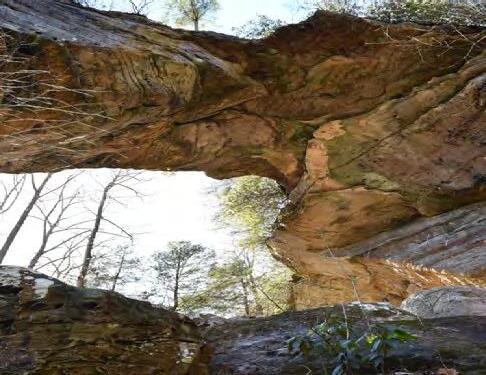

natural bridges, which are types of arches formed by a river or stream or that resemble a man-made bridge.
“Especially in the Red River Gorge, the most heavily visited part of the Daniel Boone National Forest, people have heard about the geology and want to see the arches,” said Tim Eling, public affairs staff officer for the Daniel Boone National Forest. “Compared to out west, Kentucky arches are hidden, and you don’t see them until you are literally on top of them. The National Forest is so densely vegetated, there is a thrill of hunting and discovering them.”
18 KENTUCKY MONTHLY MARCH 2023
Fern Bridge (Courtesy of Carter Caves SRP) Sky Bridge Loop Trail (Kim Kobersmith photo)
Gray’s Arch (Kim Kobersmith photo)
GUIDE TO ARCHES
Ready to explore these Kentucky natural wonders? Daniel Boone National Forest public affairs staff officer Tim Eling encouraged people to visit and enjoy the arches but to keep safety in mind. Most of the significant arches are reached by an official trail, but many others are not. A fair number of searchand-rescue operations result from hikers getting lost. Off-trail exploration should be attempted only by experienced hikers.
Eling also encouraged visitors to practice leave-no-trace principles to preserve the geological beauty. That means no rappelling and no carving in the soft sandstone.
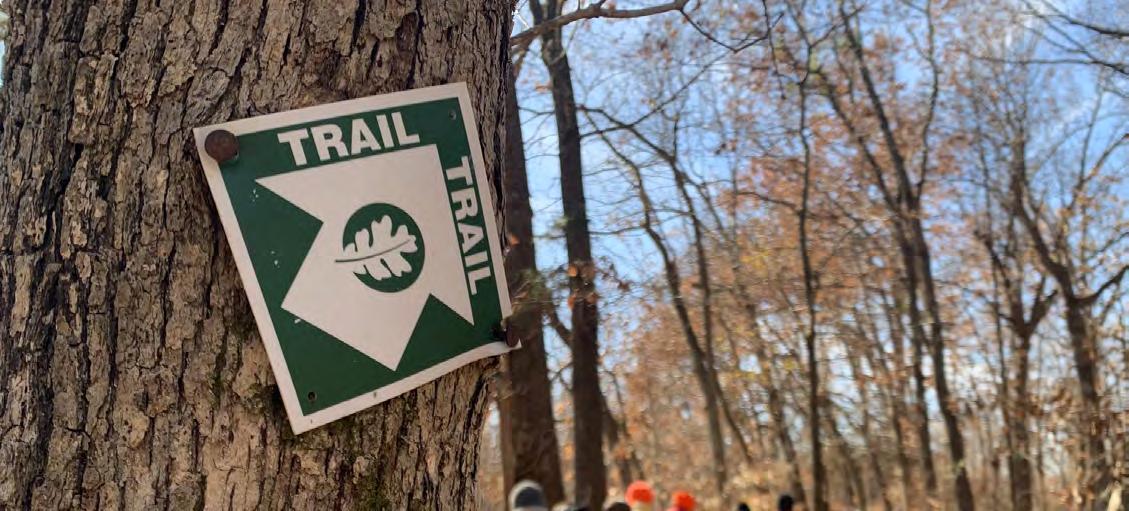
While arches can be experienced in any season, Eling recommended a winter expedition. There are fewer bugs and people, and the visibility is greater with bare trees. Lucky hikers can see giant icicles on the formations in colder weather.
HUMAN HISTORY
Nomadic hunters, the area’s first inhabitants, found shelter in the arch landscape 10,000 years ago. Small groups of European colonists began moving into the region in the 1800s. As the nation’s industries required more and more resources, densely forested eastern Kentucky became a source of lumber.
In the early 1900s, Congress set up the U.S. Forest Service to counterbalance the clear-cutting practices of timber companies. The service manages the lands in a sustainable way for watershed protection, erosion control and water quality. Proclamation boundaries of national forests in the eastern United
States designated places for the federal government to purchase lands held in private hands.
The Daniel Boone National Forest manages more than 700,000 acres spread across 21 counties of eastern Kentucky. In the 1960s, the Army Corps of Engineers proposed a dam that would flood the Forest’s centerpiece, the Red River Gorge. The ensuing controversy brought attention to the geological and archaeological treasures in the Gorge. Sustained, decades-long pressure led to their permanent conservation.
In 1974, the Forest Service designated the Gorge a Geological Area in recognition of its arches, rock shelters, towers and cliffs. Only a handful of other geographical
formations carry that classification, and the others are all out west. The Red River became a federal Wild and Scenic River in 1993, a powerful designation that will keep it forever free flowing.
The Big South Fork of the Cumberland River and its surrounding canyons were set aside in 1974 as a National River and Recreation Area. Established as a unit of the National Park Service, it was the first time the preservation and recreational goals of these designations were combined. Together, they guard the free-flowing river and its tributaries along with the natural integrity of its gorges and valleys.
kentuckymonthly.com 19
RED RIVER GORGE GEOLOGICAL AREA & NATURAL BRIDGE STATE RESORT PARK
The Red River Gorge and Natural Bridge State Resort Park lie side by side to form the best-known and most-visited spot for geological tourists in Kentucky. More than 13 impressive arches can be reached by relatively short hiking trails within the two parks.

Trailheads in the Gorge lie along the circular route of 77/715/15 and its offshoots. Try finding Hidden Arch, take a photo of your angelic child with Angel Windows, or head to one of the recommended sites below.
NATURAL BRIDGE is the only arch in the Commonwealth reachable by sky lift, which is open April through October. A network of hiking trails is available for the more adventurous. The flat, clear top makes this an ideal arch for walking across and sightseeing from the top.


SKY BRIDGE is a large sandstone arch formation that measures 23 feet high and 75 feet long. It is easily accessed by a 1-mile loop trail. Keep ahold of children and pets while crossing the top!

DOUBLE ARCH is an unusual twin arch in a more remote section of the Gorge. The bottom arch measures 30 feet long and 12 feet high. The top arch is 25 feet long and 2 feet high.
GRAYS ARCH is 50 feet high and spans 80 feet across. The arch extends off the end of a cliff and forms a buttress. It is a popular destination; hikers can see a waterfall nearby in wet weather.
WHITTLETON ARCH is accessed from Natural Bridge via a 2.5-mile out-andback hike but lies in the Red River Gorge. It is the largest arch by mass in the geological area.
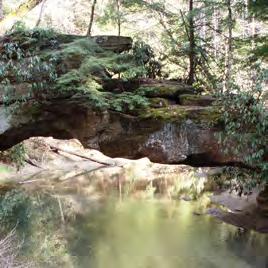
ROCK BRIDGE is the only arch in the Red River Gorge that spans a stream. The fun family loop hike, 1.25 miles long, passes scenic Creation Falls.
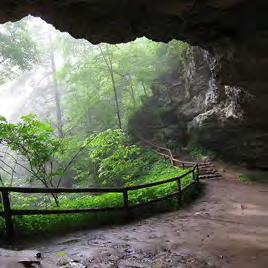
20 KENTUCKY MONTHLY MARCH 2023
Natural Bridge (Courtesy of Natural Bridge SRP)
Kim Kobersmith photo
Far left, Kim Kobersmith photo; center, courtesy of Kentucky State Parks; left, courtesy of Daniel Boone National Forest
Alltrails/Simona Barca photo
LAGRANGE
CARTER CAVES STATE RESORT PARK
Geologically, Carter Caves has it all: the highest concentration of caves in Kentucky, a box canyon, sinkholes and several significant natural arches.


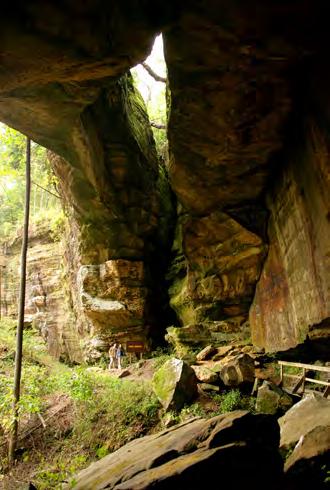
Natural Bridge is at the end of an easy half-mile hike from the park welcome center. Alternatively, visitors can drive over it on the way to a picnic area. It is the only arch in the state that supports a paved road.
The aptly named Three Bridges Trail passes by Raven Bridge, Fern Bridge and Smoky Bridge, the park’s largest. Hikers along the trail’s 3 ½ miles get close-up views of sandstone cliffs and long-range views of Smoky Lake.
502.222.4372
pillowandpaddock.com
The Pillow and Paddock Bed & Breakfast is a casually elegant country inn featuring beautifully appointed Luxury Suites. Situated in the heart of Oldham County, our tranquil 6-acre property is surrounded by picturesque rolling hills, lush pastures, beautiful estates, and thoroughbred horse farms yet just a fourminute drive from Historic Main Street La Grange and 22 miles from Louisville.
IRVINE Snug Hollow Farm
606.723.4786 snughollow.com
Snug Hollow is an organic farm that boasts 300 acres of babbling creeks, glorious wildflowers, abundant wildlife, wooded mountainsides and the simplicity of country life both past and present. The area is Appalachia at its best and a stay is an authentic experience in “holler hospitality.”

kentucky b&b
recommendations
PADUCAH Belle Louise Historic Guest House
270.210.2553
bellelouisepaducah.com
LA GRANGE Bluegrass Country Estate 502.222.2009
bluegrasscountryestate.com

BARDSTOWN Bourbon Manor 502.350.1010 | bourbon.com
BURLINGTON Burlington’s Willis Graves Inn 859.689.5096 | willisgraves.com
PARK CITY Grand Victorian Inn 270.590.1935 | grandvictorianinnky.com
SPRINGFIELD Maple Hill Manor 859.336.3075 | maplehillmanor.com
WARSAW Riverside Inn 859.567.1399 | riversideinnbb.com
LIVERMORE River Trails Inn
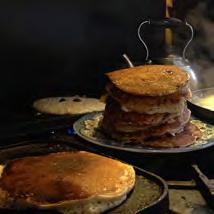

airbnb.com/rooms/38361408
SONORA
Thurman Landing 270.949.1897 | thurmanlanding.com
kentuckymonthly.com 21 SPECIAL ADVERTISING SECTION
staycation
plan a
Pillow and Paddock
Fern Bridge, center; Smoky Bridge, bottom (Images courtesy of Carter Caves SRP)
BIG SOUTH FORK NATIONAL RIVER AND RECREATION AREA & DANIEL BOONE NATIONAL FOREST

In southern McCreary County, preserved lands of the Big South Fork intertwine with those of the Daniel Boone National Forest. A guidebook, Natural Arches of the Big South Fork: A Guide to Selected Landforms, authored by former Big South Fork Park Ranger Arthur McDade, highlights 25 of the area’s accessible formations. Here are some favorites.


SPLIT BOW ARCH is one of the most accessible arches in the Big South Fork. You can see the 51-foot-wide formation from an overlook just 100 feet from a small parking area or on a 11/3 -mile round-trip hike that takes you through the arch.


KOGER ARCH is impressive at 54 feet wide, 18 feet high and 91 feet across. The arch is one-third of a mile from the off-the-beaten-path trailhead.
NATURAL ARCH is an impressive 50 feet by 90 feet and can be viewed from a short paved trail in its namesake picnic area. A 1-mile loop trail takes hikers to the base and around the formation.
YAHOO ARCH and MARKERS ARCH can be reached in a 3-mile round-trip hike from the Yahoo Arch trailhead. Yahoo was created by erosion at the back of a rock shelter, and the surrounding interlaced roots and abundant rhododendron give the area a Tolkien-like feel.

22 KENTUCKY MONTHLY MARCH 2023
Bill Fultz
photo

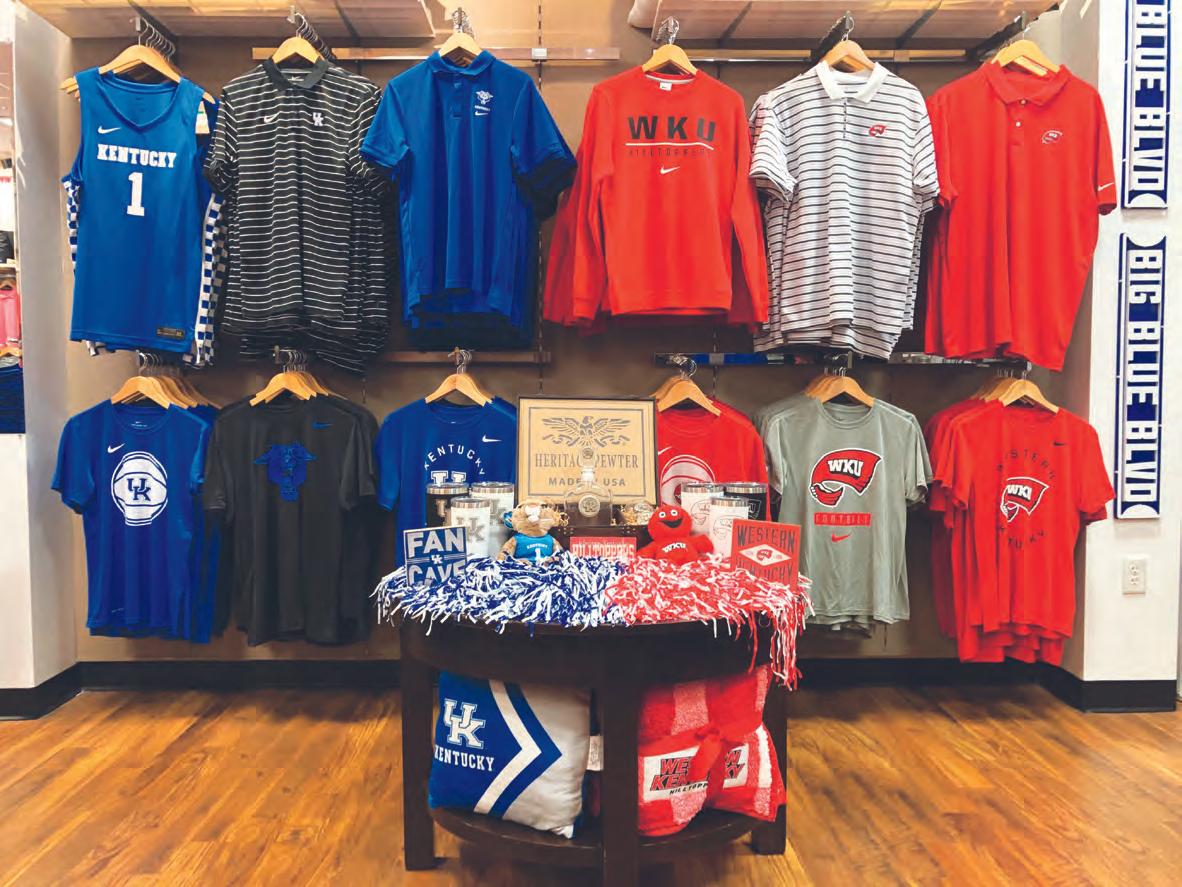

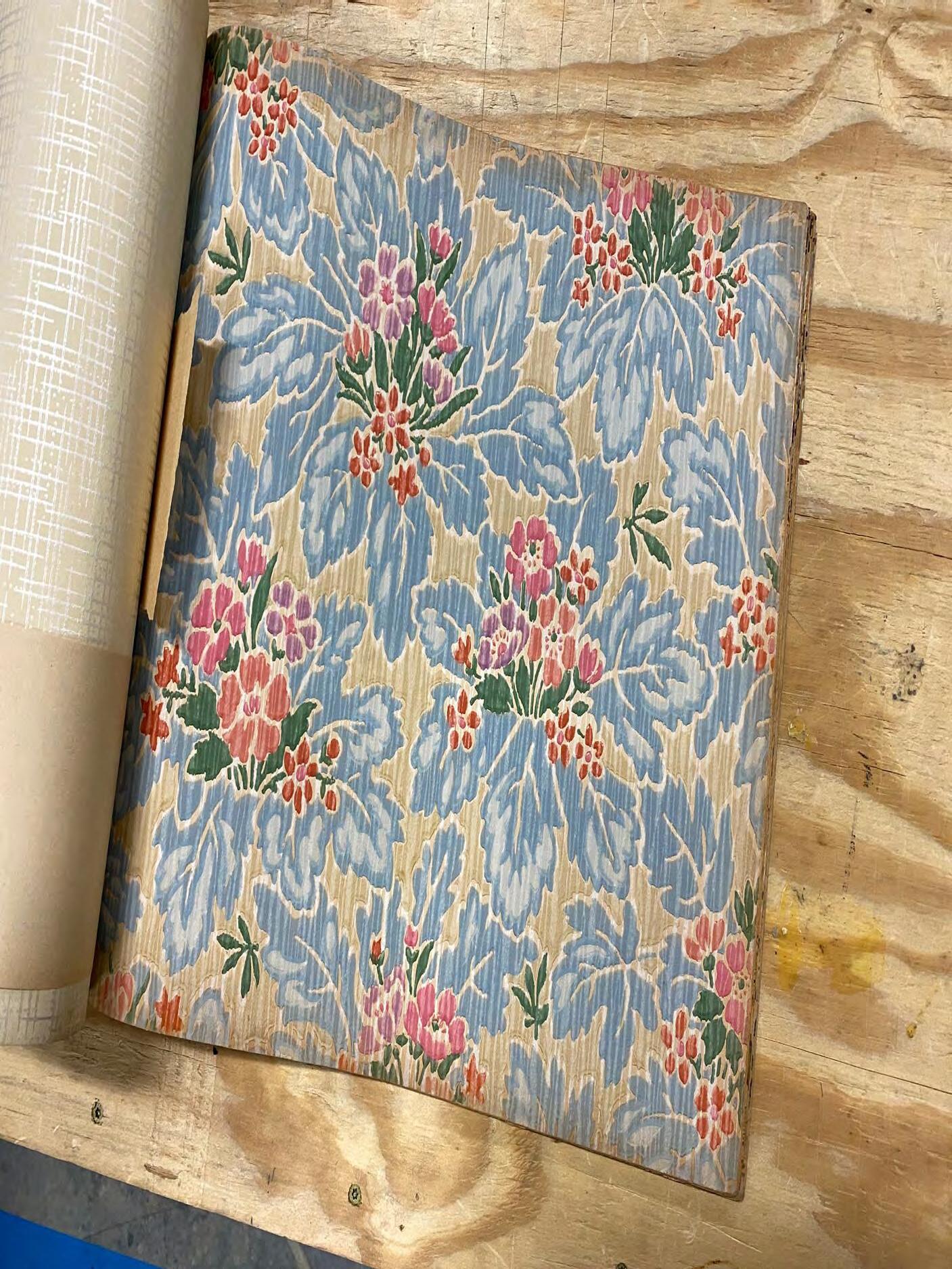



KENTUCKY GATEWAY MUSEUM CENTER 215 Sutton Street Maysville, Kentucky 41056 606-564-5865 www.kygmc.org Hours: Tuesday-Saturday 10am-4pm The Old Pogue Experience located in the limestone building on the corner of sutton & west 2nd Streets kygmc campus On Display: February 1-August 31 Calvert Gallery $2 per Student $10 per Individual
A WESTERN ARCH
Do you live in western Kentucky or are you planning a visit to the area?
Explore an arch there! The Mantle Rock Nature Preserve’s namesake arch spans a massive 188 feet. Protected by The Nature Conservancy, the 367-acre landscape is open to hikers during daylight hours.

nature.org/en-us/get-involved/how-to-help/ places-we-protect/mantle-rock-preserve
RESOURCES FOR EXPLORING KENTUCK Y ’ S ARCHES
The recently renovated GLADIE VISITOR CENTER in the Red River Gorge is a great place to get oriented, pick up a guidebook, and purchase professional photos of the arches. It is closed for the winter. Find them on Facebook to check open times.
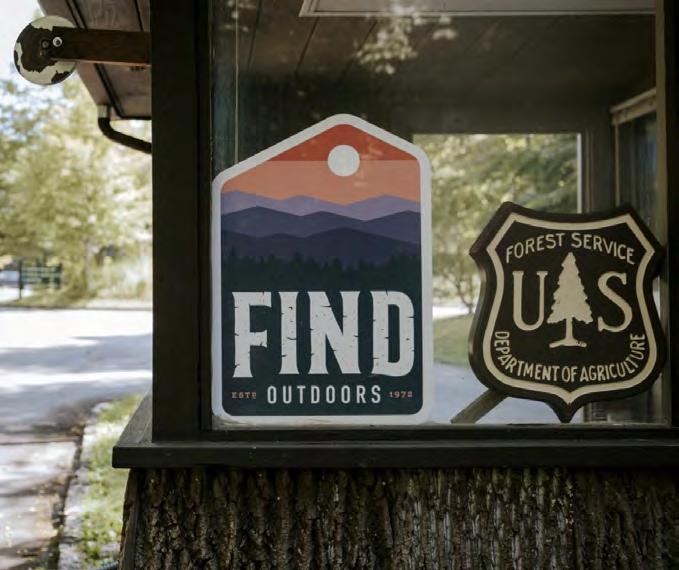
NATURAL ARCHES OF THE BIG SOUTH FORK: A GUIDE TO SELECTED LANDFORMS
 BY ARTHUR M c DADE
BY ARTHUR M c DADE
The Big South Fork region, which straddles the KentuckyTennessee border, boasts some incredible natural arches. Carved over centuries by water and weather, many of these landforms can be viewed and visited by hikers. Arthur McDade’s The Natural Arches of the Big South Fork is the quintessential guidebook for those seeking to explore this geographically rich area.
24 KENTUCKY MONTHLY MARCH 2023
NATURAL BRIDGE STATE RESORT PARK CARTER CAVES STATE RESORT PARK DANIEL BOONE NATIONAL FOREST BIG SOUTH FORK NATIONAL RIVER + RECREATION AREA
SCAN THE QR CODES TO LEARN MORE
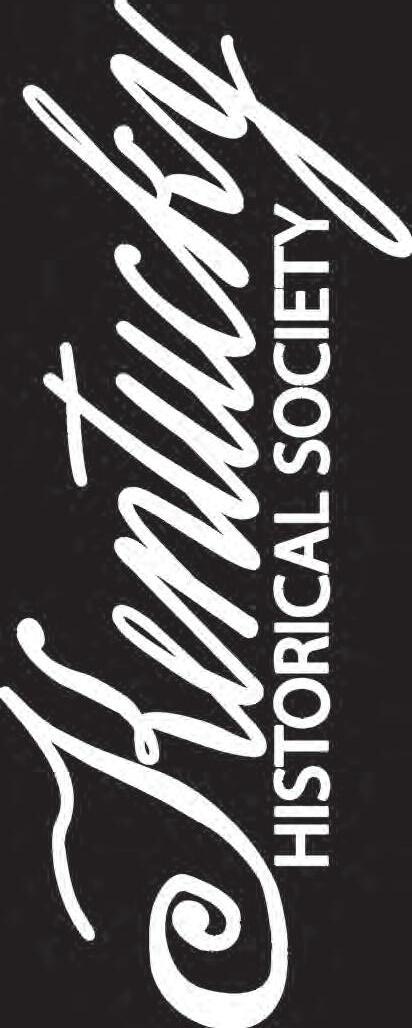



kentuckymonthly.com 25 Make Your Mark for History on Your State Income Tax Return Give to the Your donation goes to a grant pool to help museums, libraries, and history organizations in your community. history.ky.gov/lhtf Graduate Programs ■ The Gifted and Talented Endorsement ■ MAE in Gifted Education and Talent Development ■ EdS in Gifted Education and Talent Development Programs for Gifted Students ■ Super Saturdays ■ The Summer Camp for Academically Talented Middle School Students ■ The Summer Program for Verbally and Mathematically Precocious Youth ■ Camp Explore ■ Camp Innovate Other Amazing Programs ■ IdeaFestival Bowling Green ■ Travel Abroad ■ Professional Development ■ Talent Identification Program of Kentucky (TIP-KY) ■ And so much more! Learn more at wku.edu/gifted 270-745-6323 | gifted@wku.edu THE CENTER FOR GIFTED STUDIES Climb With Us
Ancient Culture and Natural Beauty
Wickliffe Mounds State Historic Site offers prehistoric artifacts and stellar scenery in one spot
BY DAVID PYLE
For lovers of nature and history, there’s a scenic though sometimes overlooked spot in far western Kentucky steeped in both. It lies just outside the town of Wickliffe, three miles from the confluence of the Ohio and Mississippi rivers.
Wickliffe, sometimes known as the birthplace of the Mighty Mississippi because it is joined by the Ohio River near the town’s location, is renowned as the site of Fort Jefferson, an important outpost during both the American Revolution and the Civil War. But the most popular destination in the area is the famed Wickliffe Mounds State
Historic Site at 94 Green Street.
“Wickliffe Mounds is a prehistoric site linked to the Mississippian culture, which once flourished in the area,” said park manager Carla Hildebrand. “It is listed on the National Register of Historic Places and recognized as a Kentucky Archaeological Landmark.”
The Ballard County park contains a great deal of history, and many interesting activities await visitors. The Wickliffe Mounds site is part of the Great River Road National Scenic Byway and the Lewis and Clark National Historic Trail Route. The park provides hikers an abundance of natural scenery to admire and the opportunity to watch the foliage
change during spring, summer and fall. It is open April through midNovember, with fall and winter visits by appointment.
The highlight of a visit to Wickliffe Mounds State Historic Site is the ancient mounds left behind by the peoples of the Mississippian culture. They are the remnants of a Native American village that once stood on the site and thrived in the area from 1100 to 1350 A.D.
During that time, the Mississippian people built earthen mounds around a central plaza overlooking the Mississippi River. Centuries after the site’s

• • •
26 KENTUCKY MONTHLY MARCH 2023
abandonment, it is a treasure of important information about the ancient peoples who once inhabited the land and the abundant wildlife that thrived there.
Wickliffe was an important ceremonial and administrative center in the Mississippian culture. At its peak, the population probably reached into the hundreds. The site is dominated by two large platform mounds. At least eight smaller mounds are scattered around a central area.
The area’s agriculture centered around maize, which was stored and helped support the overall society. The social hierarchy was ruled by a hereditary chief.

It is believed that abandonment of the site began around 1350, as the population slowly relocated several miles northeast. Excavation of the site began around 1913 and continued sporadically for years. In 1932, Fain W. King, an amateur archaeologist and artifact collector, helped launch large-scale excavations of the center portions of three mounds.
The historic site was added to the National Register of Historic Places in 1984. In 2004, it became the 11th State Historical Site of Kentucky and came under control of the Kentucky State Parks.
IF YOU GO...
Wickliffe Mounds
State Historic Site
94 Green Street, Wickliffe
270.335.3681
parks.ky.gov/wickliffe/parks/historic/ wickliffe-mounds-state-historic-site
Open April 1 through mid-November, then open by appointment only.
ADMISSION:
$6 for adults
$5 for seniors (ages 62 and up)
$4 for children (ages 5-15)
$3 for active-duty military members.
For groups of 10 or more, please call to schedule a visit. Please call the park office for questions regarding the pet policy.
Along with the impressive and intriguing mounds, visitors can view the excavated treasures in the site’s museum—pottery, stone tools, artifacts and artwork showcasing the Mississippians and the history of Native American tribes in Kentucky. Examining the shell-tempered clay with elaborate designs and decorations, visitors can get an idea of the everyday lives of the area’s ancient inhabitants.
The ancient culture used stone, shell and bone tools and lived in permanent homes made of wattle and daub, built by using branches or river reeds that then were covered with clay and straw.
With no modern technology, the
kentuckymonthly.com 27
• • •
Natives also built the flat-topped platform-style mounds.
The museum presents a view of an excavated mound with archaeological features, site artifacts and a mural depicting the ancient culture that once lived there.
The mounds first were explored in relatively recent times. In 1888, surveyor Robert Loughbridge mapped the mounds for the Commonwealth of Kentucky. From 1895-1932, the site was owned by the Wisconsin Chair Company. In the 1980s, it came under control of Murray State University in Murray and remained in MSU’s care until it was designated as a State Historic Site.
The largest of the mounds, the Ceremonial Mound, was the location of ceremonial structures. It would have been the political and religious center of the community. The bluff area from the top of this mound presents a spectacular view of the area.

“Throughout the season, the park hosts numerous activities,” Hildebrand said. “Included are hands-on displays, events, demonstrations and educational programs. The park opens April 1, and activities soon kick off with a natural environment event. Then in September, we host our popular Archaeology Day in conjunction with Kentucky Archaeology Month, though specifics for these events have not yet been finalized” for 2023.
Wickliffe Mounds State Historic Site offers choice spots for birdwatchers to purse their favorite hobby. They are encouraged to visit the bluff picnic area, the Woods Walk Trail and the Ceremonial Mound. A local favorite for birders is the pileated woodpecker, most active during the morning hours as its cackle rings throughout the park.
Other favorites are the great blue heron, cattle egret, killdeer, redwinged blackbird and belted kingfisher. Early spring and late fall/ early winter are the best times to catch sight of Canada geese. Many other colorful feathers can be seen, thrilling the avid watcher and other interested visitors.
Resident woodland birds include the turkey, yellow-billed cuckoo, great horned owl and eastern screech owl.
To help point bird lovers in the right direction and keep track of their sightings, birding pamphlets and checklists are available at the park’s welcome center.
Whether on the lookout for birds or soaking up nature’s bounty, visitors can enjoy a walk through the woods on a 200-yard loop trail that offers views of in-season wildflowers, wildlife and trees. The Mississippi River is just across the highway from the park and can be viewed from the vantage points of where the Natives
fished and the forest in which they hunted. If you’re lucky, you may discover an arrowhead.
After a leisurely exploration of nature, visitors can stop for lunch or a snack at a picnic table located in the tranquil bluff area. More tables and a shelter can be found in the paid-admission area of the site.
At the park gift shop, visitors may purchase books, souvenirs, pottery, baskets and other treasures to remind them of their visit.
Admission fees are reasonable and help maintain the park.
“For those who wish to stay overnight, there is camping at the Columbus-Belmont [State Park], 18 miles south,” Hildebrand said. Hotels are available nearby, and Paducah is a 30-minute drive.
Visitors may enjoy the local fare at several mom-and-pop diners in Wickliffe and the surrounding area. Among the most popular stops in town are the Kentucky Hillbilly BBQ, Mike’s Place and Crossroads Café & Deli.
Hildebrand invites all to see what life was like in another time and enjoy the natural surroundings at Wickliffe State Historic Site. Q
For specific dates and information on Wickliffe State Historic Site’s events and festivities, contact Park Manager Carla Hildebrand at 270.335.3681 or carla.hildebrand@ky.gov.
28 KENTUCKY MONTHLY MARCH 2023
• • •
Presented by
FRIDAY, MARCH 24 - SATURDAY, MARCH 25



Knicely Conference Center, 2355 Nashville Road, Bowling Green, KY
MAIN EVENT: SATURDAY, MARCH 25, 9 A.M. - 2 P.M.
FEATURING WIL WHEATON, KEVIN WILSON, JOHN SCALZI, CRYSTAL WILKINSON, SILAS HOUSE AND MORE!








CHILDREN’S DAY: FRIDAY, MARCH 24, 9 A.M. - 1 P.M.

FEATURING LAUREN TARSHIS, CHARLES GHIGNA, SHAWN PRYOR AND OTHER PICTURE BOOK, CHAPTER BOOK, MIDDLE GRADES AND YOUNG ADULT AUTHORS AND ILLUSTRATORS!





FREE ADMISSION! SEE THE FULL LINEUP AT SOKYBOOKFEST.ORG.

LOOK WHO IS COMING
ABOUT SOKY BOOK FEST





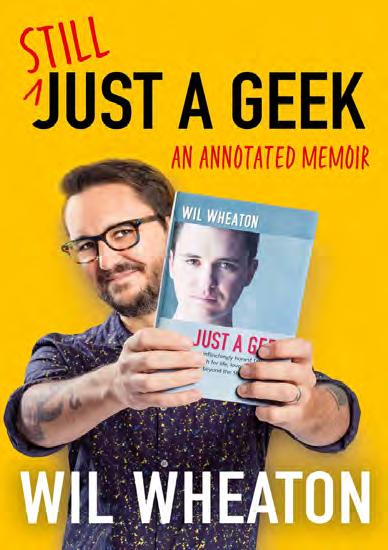

The SOKY Book Fest, one of Kentucky’s largest literary events, draws thousands of readers of all ages excited to meet their favorite authors and purchase signed copies of their books. The Book Fest partners—Barnes & Noble Booksellers and Warren County Public Library, work together to organize a variety of events designed to fulfill our mission: to encourage literacy and the love of books. Our free events wouldn’t be possible without generous support from our sponsors and community!
Please note, all books signed at SOKY Book Fest must be purchased at the event. Proceeds from books purchased help us to continue our mission. Thank you!



KEVINWILSON
LAU
R E N TARSHI CHARLESGHIGNA S USAN VERDE WIL W H EATON
30 KENTUCKY MONTHLY MARCH 2023
Southern Kentucky Book Best is one of the state’s largest literary events and is presented by Barnes & Noble Booksellers and Warren County Public Library. Held annually, the Book Fest draws thousands of readers of all ages who welcome the occasion to meet their favorite authors and purchase signed copies of their books.
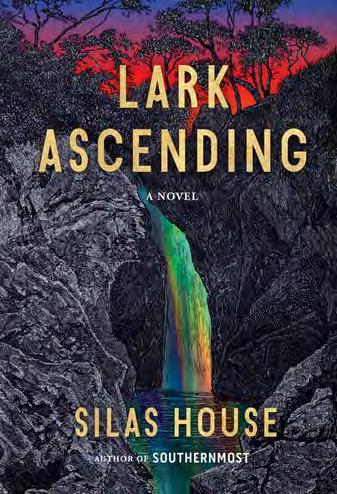
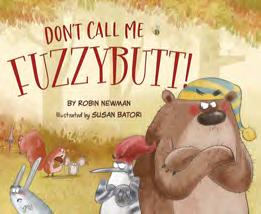


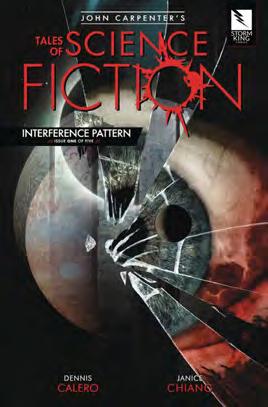




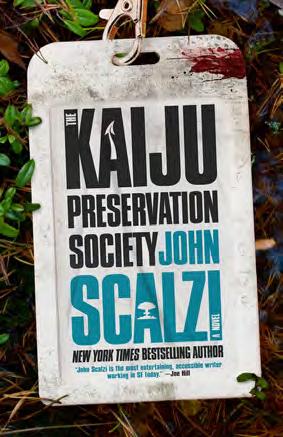
FICTION
BENNINGTON, MICHELLE Devil’s Kiss
BOND, GWENDA
Mr. and Mrs. Witch
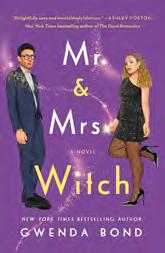
BROWN, GERRY HARLAN Ring the Bell
CALERO, DENNIS Spoiler
CARPENTER, DANA Book of the Just
DELAY, CHRISTINA Truth Truth, Lie Song of Curses
DINAN, NANCY WAYSON
Things You Would Know If You Grew Up Around Here
DREW, ALAN The Recruit

FALIN, BOBBIE Flashing Dark
FELDMANN, DOUG
The Dean of Clinton County: A Baseball Novel
FORD, ED
The Necessities of Life
FREY, REA
The Other Year
GABHART, ANN When the Meadow Blooms
HOUSE, SILAS Lark Ascending
HUDSON, PATRICIA Traces: A Novel

JACKSON-BROWN, ANGLEA The Light Always Breaks

JACOBS, R.J.
Always the First to Die: A Novel
KELL, CARL Good Night … Whispers of the Heart
MARTIN, LEE
The Glassmaker’s Wife

MOORMAN, JENNIFER
The Baker’s Man

NOVEY, IDRA Take What You Need
ROWE, CHRISTOPHER
These Prisoning Hills
SCALZI, JOHN Kanju Preservation Society
SCHULTZ, STORM Meant to Be
SHAFFER, ANDREW Feel the Bern: A Bernie Sanders Mystery
STOVALL, SHELIA Every Day Filled With Hope
THOMAN, LAUREN I’ll Stop the World
VERDE, SUSAN Say One Kind of Thing
WILSON, KEVIN Now Is Not the Time to Panic
MIDDLES GRADES
BURKS, JAMES Agent 9: Mind Control, Bird and Squirrel and Haggis and Tank
DUBOIS, CAROLINE BROOKS Ode to Nobody
ELLIOTT, RACHEL
The Real Riley Mayes
GOW, ROBIN Dear Mothman
HOWARD, GREG The Visitors
32 KENTUCKY MONTHLY MARCH 2023
LOCKINGTON, MARIAMA In the Key of Us
PRYOR, SHAWN A Dangerous Duo
ROBERTS, A.G.
LITE: The High Treason Incident
TARSHIS, LAUREN
I Survived Series –The Wellington Avalanche
TUBB, KRISTIN
The Decomposition of Jack
NONFICTION
AJMERA, ANANTA RIPA
The Way of the Goddess
BINGHAM, EMILY S.
My Old Kentucky Home: The Astonishing Life and Reckoning of an Iconic American Song
BROWN, TIM God and A Man
BRYAN, PATRCIA
The Plea: The True Story of Young Wesley Elkins and His Struggle for Redemption
COOK, KEVIN DEAN House of Champions: The Story of Kentucky Basketball’s Home Courts

DETERS, ERIC Butcher of Pakistan
GIVENS, ROGER A History of Woodbury, Kentucky: A Once Thriving Riverboat Town
HOWARD, JASON A Few Honest Words
KEANE, ERIN Runaway: Notes on the Myths That Made Me

LEONARDS, H.H. Rosa Parks Beyond the Bus: Life, Lessons, and Leadership

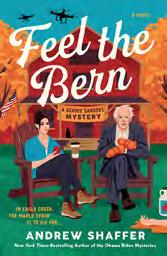
MARTIN, TRAVIS L. War and Homecoming: Veteran Identity and the Post 9/11 Generation
MOSS, JAMES PAISLEY My Recovery Companion
REILY, STEPHEN Promise, Witness, Remembrance
SWIETEK, WES Cemetery Road Murders

TURLEY, ALICESTYNE The Gospel of Freedom
WEST, GARY P. Murder on Youngers Creek Road
WHEATON, WIL Still Just a Geek
WOLF, THOMAS
The Plea: The True Story of Young Wesley Elkins and His Struggle for Redemtion

PICTURE BOOKS
ADAMS, MARK WAYNE Stick Horse Derby
DADEY, DEBBIE
Never Give Up: Dr. Kati Karikó and the Race for the Future of Vaccines
FREEMAN, KIM Ice Cream Man
FULTZ, LANEY GRACE Wash Em Down
GHIGNA, CHARLES Little Hearts
kentuckymonthly.com 33
GILL, EMILIE The Tall Tale of the Giant’s Causeway
HALCOMB, LATRELL Brownie Boy
HOFFMAN, ELIZABETH ROSE Here I’m Happy
KENYON, RACHEL TAWIL Alphabet Love
LARSEN, MYLISA Playing Through the Turnaround
LEVIS, CAMERON Home Is Where Your Park Is
MATTHEWS, TONYA A Girl’s Christmas Gone Perfectly Wrong
NEWMAN, ROBIN Don’t Call Me Fuzzybutt
PACK, TIMOTHY A. Skacky: Aventures in Imagination
THURMAN, BRITTANY J. Fly
TRABUE, JAN Kaboom!
UHLES, MARY REAVES Let’s Pop, Pop Popcorn

VERDE, SUSAN Can You See It?
YOUNG, JESSICA Baby’s Here!
POETRY
WILKINSON, CRYSTAL; DAVIS, RONALD W. (ILLUSTRATOR) Perfect Black

WORTHINGTON, MARIANNE The Girl Singer: Poems
YOUNG ADULT
ALVAREZ, JENNIFER LYNN Friends Like These
ARNOLD, DAVID The Electric Kingdom
BARTON, NOEL Lucretia
BELL, DAVID She’s Gone
CAMERON, SHARON Artiface
DAVIS, BROOKE LAUREN After Dark with Roxie Clark
DUNBAR, HELENE The Promise of Lost Things
FARYN, KRIS
Song of Curses: A Young Adult Dark Fantasy
FELDMAN, JODY No Way Home
HENSON, HEATHER Wrecked
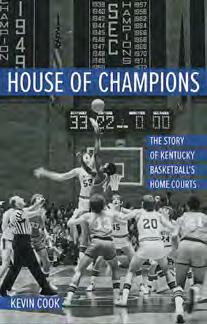

KLAPHEKE, ALISHA Fate of Dragons
LAMB, SHAWN Shield Maiden of Eldar
LYNNE, DAKODA Hitman
PROSEK, BRYAN The Darker the Skies
REDWINE, C.J. Rise of the Vicious Princess
STEVENS, COURT We Were Kings
VACA, JULIAN The Memory Index
ZENTNER, JEFF In the Wild Light

34 KENTUCKY MONTHLY MARCH 2023
KENTUCKY WRITERS CONFERENCE
Saturday, March 25, 2023 | 9 AM –1 PM | Knicely Conference Center
SESSION 1 9AM
ANN H. GABHART
Fiction Is People ROOM 112
People read fiction for its characters more than any other element, and the stories they love best are the ones with characters who find a place in their hearts. Ann H. Gabhart will share what she’s learned in the process of bringing many characters to life in her 37 published novels.




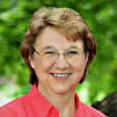
SHARON CAMERON
Write a Novel… Right Now! ROOM 113
Ask the right questions, and anyone can write a novel. It’s as simple as that. Come ready to write in this fastpaced, hands-on workshop, and in one hour, leave with your own unique novel or short story skeleton, ready to be developed. And most importantly, ready to be finished.
SESSION 2 10AM
IDRA NOVEY
Old Wolf, New Pajamas A Master Class on Writing in the Present, Subverting Fairytales of the Past ROOM 112
We’ll discuss how fairy tale elements may recede as a new piece of fiction develops, providing a way in, though not necessarily a way out.
C.J. REDWINE
5 Mistakes New Authors Make ROOM 113

Publishing has a steep learning curve. Cut that learning
curve in half by learning what mistakes you’re currently making and how to easily correct them! New York Times best selling author C.J. Redwine will walk you through the process in this fun, interactive workshop and send you on your way feeling equipped and inspired.
SESSION 3 11AM
DANA CARPENTER
The Art of the Query Letter
ROOM 112
When there are lots of folks fishing at the same pond, using the right bait can make the difference between having catfish for supper or going home empty handed. It’s no different when trying to land an agent or hook a reader. Mastering the art of the query is a vital and necessary skill for any writer looking to publish. In this interactive session, learn how to craft an engaging, professional query with a dynamic description of your book.
MARIANNE WORTHINGTON
The Voice of the Poem: A Generative Workshop
ROOM 113
This generative workshop will explore ways to focus on the voice of a poem—that unique presence that speaks a poem. We will work to claim and speak our memories and give ourselves permission to speak in our own voices. We’ll also study methods to claim the essence of other voices and practice writing poems in persona. This workshop can help us explore how we can use voice to change our perspectives, try out other voices, and discover empathy. At the end of the workshop, participants will have two or three drafts for new poems.
SESSION 4 12PM LEE MARTIN Writing the Riven Heart ROOM
112
William Faulkner, in his 1950 Nobel Prize acceptance speech, called attention to the pressures of writing in the Atomic Age, claiming young writers were neglecting “the problems of the human heart in conflict with itself which alone can make good writing because only that is worth writing about, worth the agony and the sweat.” I’ll tell the story of my writer’s journey, paying special attention to my discovery of what I like to call touchstone moments from memory, moments that come from my own riven heart. I’ll give you a writing exercise that will invite you to begin thinking about your own memories and how to use them to create memorable and resonant work.
JASON HOWARD More Than Landscape: Writing A Deeper Sense of Place

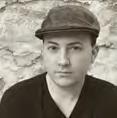
ROOM 113
In this session, noted essayist and creative nonfiction writer Jason Kyle Howard will explore the necessity of moving beyond setting and geography in capturing place. Through lecture, discussion and written exercises, he will offer insightful tips on how to expand our notion of place to create a more visceral, immersive narrative on the page.
SCAN CODE TO REGISTER OR VISIT
PROGRAMS/KY-WRITERSCONFERENCE/ kentuckymonthly.com 35
SOKYBOOKFEST.ORG/
SATURDAY, MARCH 25 TH 9 AM –2 PM

163A-C (610) AUDITORIUM (160) REGENCY (400) ROOM 116
POETRY
Crystal Wilkinson, Ronald Davis
9:00 All panels, workshops and presentations are open entry until each room is at capacity.
WIL WHEATON

AFRICAN AMERICAN HISTORY


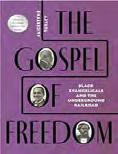
10:00
SILAS HOUSE AND KEVIN WILSON IN CONVERSATION

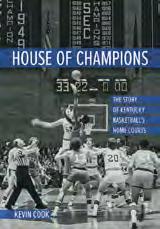




11:00
INSPIRATIONAL FICTION



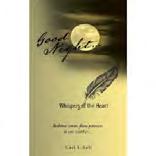


Noel Barton, Shelia Stovall, Storm Schultz

Register for the Writers Confrence
H.H. Leonards, Alicestyne Turley, Angela Jackson-Brown MAKE SURE TO BUY A BOOK TO GET SIGNED!

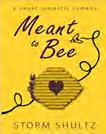



FICTION
Patricia Hudson, Jennifer Moorman, Rea Frey
PICTURE BOOKS


Cameron Levis, LaTrell Halcomb
TASTE OF LOCAL
Carl Kell, Gerry Brown, Wes Swietek, Paul Bass

DENNIS CALERO NON-FICTION
Susan Verde, Ananta Ripa Ajmera
12:00
Lauren Tarshis MYSTERIES

David Bell, Alan Drew, Michelle Bennington, R.J. Jacobs
1:00
FICTION
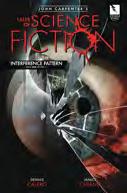
Sharon Cameron, Courtney Stevens, Jeff Zentner, Lauren Brooke Davis
KENTUCKY

Paul Bass, Emily Bingham


FICTION FRIENDS
John Scalzi, Gwenda Bond, Christopher Rowe, Lauren Thoman








SPORTS
Kevin Cook, Thomas Wolf, Doug Feldman
36 KENTUCKY MONTHLY MARCH 2023






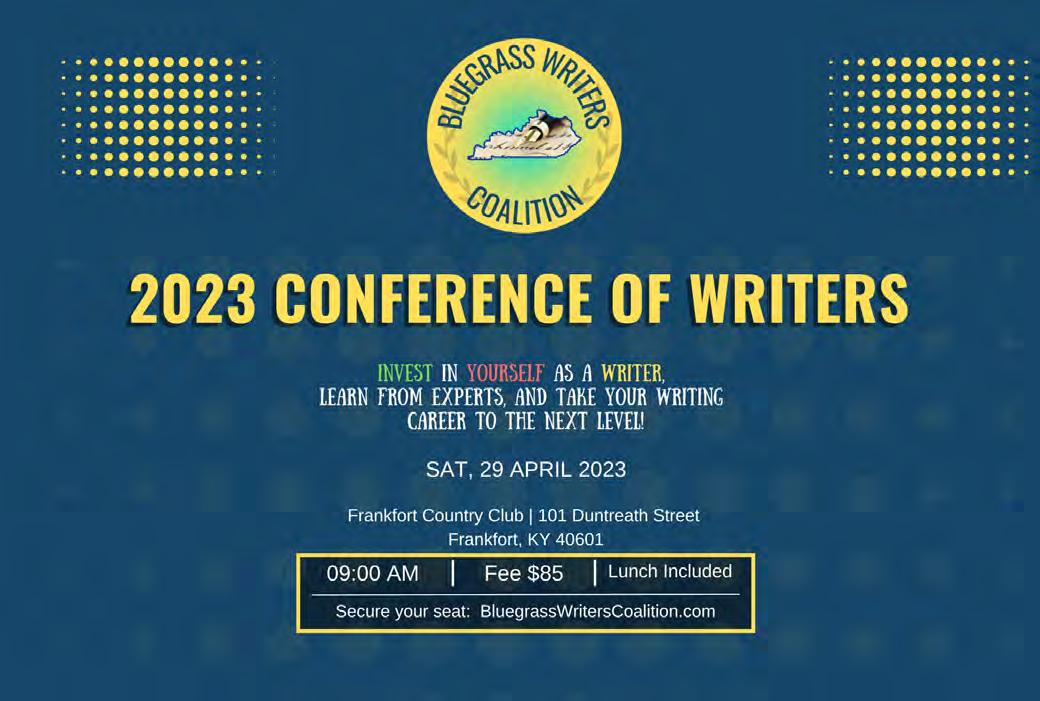
kentuckymonthly.com 37 Nationally-Recognized Heart Care Heart & Vascular Institute (606) 430-2201 | pikevillehospital.org
Images and Emotions

A traveling photography exhibit uses positive images to motivate viewers to feel compassion and take action
BY JACKIE HOLLENKAMP BENTLEY
The finishing touches are underway at Lexington’s Headley-Whitney Museum for Shades of Compassion, an interactive and multiphotograph exhibit featuring the work of notable photographers such as Ansel Adams and Imogen Cunningham. The museum is the first stop for the international traveling exhibit, which will run April 8 through June 18.
“To premiere this inclusive, thought-provoking and inspiring exhibition of work by international photographers is certainly an honor,” said Christina Bell, executive director and curator for the Headley-Whitney Museum. “And bringing light and understanding to a subject that is as much needed as compassion is truly the most important part of this exhibit.”
The exhibit, which features 50 photographs from 41 photographers, is part of the Shades of Compassion Foundation’s mission to create and support compassionrelated initiatives worldwide.
COMPASSION AND SCIENCE
The widely accepted definition for compassion is “sympathetic pity and concern for the sufferings and misfortunes of others” (Merriam-Webster Dictionary). But Foundation President Dr. Jon Kolkin takes it one step further.
“Compassion is the intention to help anyone who might benefit, whether it is self or whether it is others, out of a true concern for their well-being and not what I
38 KENTUCKY MONTHLY MARCH 2023
Christ in the garden; Abbey of Gethsemani, New Haven

kentuckymonthly.com 39 PHOTOGRAPHY BY GUY MENDES
can get out of it,” Kolkin said. “I think it has come to the forefront now, more as something that people feel is urgently needed.”
Kolkin said this exhibition is unique in how it motivates a person to act. The 50 images on display don’t necessarily show human suffering and destruction. Rather, they are meant to stir positive emotions.
“We wanted to make sure that whatever we put together was based on what really works, not kumbaya ideas that we pat ourselves on the back and then it doesn’t go anywhere,” Kolkin said. “Trying to motivate people toward socially relevant causes by exposing and bombarding them with all this tragedy is counterproductive … [The photographs] are specifically selected to motivate people out of a true sense of caring, so they’re more positive images, more where we can connect with our hearts in a positive way … rather than with destructive emotions.”
The photographs are categorized across three perspectives: environment, humanity and spirituality. Each perspective is accompanied by Meditation Stations as well as Pause Stations for deeper exploration. An Action Station at the end of the exhibition will provide visitors online resources, including local nonprofits, to further promote compassion in their community, as well as a writing area where they can share their thoughts and emotions.
EXPANDING ON THE EXHIBITION
To complement the international exhibit, the Headley-Whitney is featuring the work of photographer, author and preservationist Linda Bruckheimer. The Other Side of the Story will present photographs Bruckheimer has taken on her many world travels.

The Kentucky native is no stranger to the HeadleyWhitney, and her exhibit, A Colorful Crowd, recently appeared there. Bruckheimer said she wasn’t sure her work would “fit in” with the Shades of Compassion exhibit, as it was a change of pace from the previous exhibit and the photos her Kentucky collectors are more familiar with.
“But inspiration struck quickly,” Bruckheimer said. “I began editing the hundreds of photos I’ve taken through my years of travel, and I was quite surprised at what developed. As this reality blossomed before me, my reticence turned to excitement. I was so anxious to give these individual photos a torso, one that would evoke a myriad of feelings and connectivity.”
A self-proclaimed “tagalong” when her husband, television and film producer Jerry Bruckheimer, travels to shoot a movie, Linda said she looks for “the grit, the character, the innards of the region” she’s visiting, providing her with what she calls “an embarrassment of photographic riches” in her portfolio.
“All these locations and the people who populate
40 KENTUCKY MONTHLY MARCH 2023
Nodding trillium; Marble Creek, Jessamine County
IF YOU GO...
SHADES OF COMPASSION EXHIBIT
April 8-June 18
Headley-Whitney Museum
4435 Old Frankfort Pike, Lexington 859.255.6653
headley-whitney.org

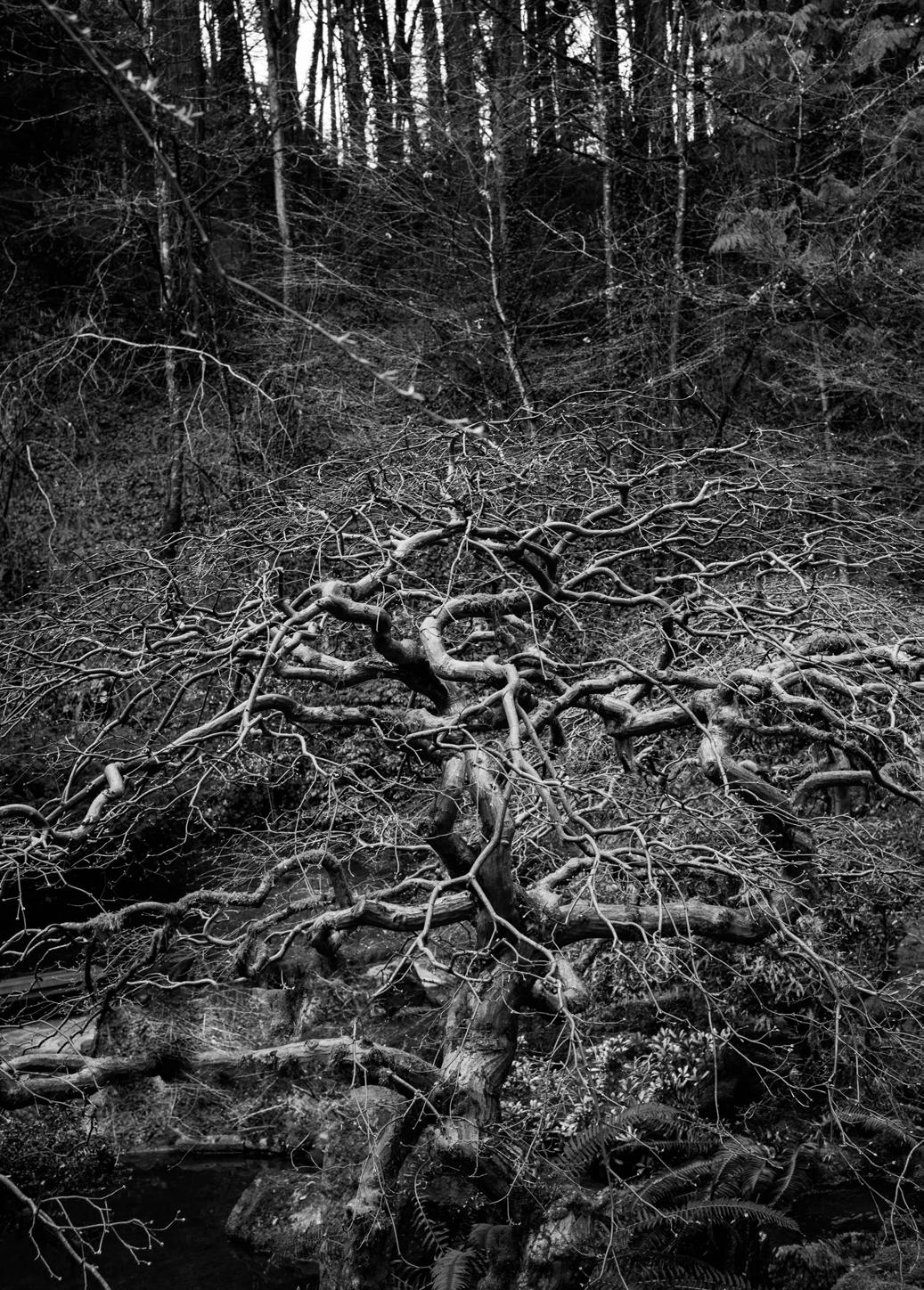
MUSEUM HOURS
Friday-Sunday, 10 a.m.-4 p.m.
Admission: $10
kentuckymonthly.com 41
Japanese garden; Portland, Oregon
them, the life they live and the emotions they generate, were too good to leave under cover,” she said. “They also tell a bigger story—one that captures the stark differences in cultures and landscapes yet tethers them together with the proverbial common thread.”
ADDING A BLUEGRASS STATE TOUCH
To further deepen the exhibit experience, Bell curated a collection of work by Kentucky photographers, including James Baker Hall, Melissa Watt, Bill Roughen, Deirdre Lyons, Marcia Hopkins, Boo Hardy, Chris Yarber, Maja Willow Linden and Guy Mendes.
Like Bruckheimer, when first asked to contribute, Mendes told Bell he wasn’t sure his work would fit in.
“I told Christina [Bell] that when I go out to photograph, I don’t go out thinking, ‘I’m going to be compassionate today,’ ” Mendes said. “I’m looking for the light and the light on the surface of the planet here. I’ve been photographing for many years now, and I’m still looking for the next beautiful image, whether it’s of a creek or someone’s parlor.”
Eight of Mendes’ photos are included in the exhibit, showcasing the beauty of Kentucky and the world, and the compassion needed to keep it that way.
“Kentucky is one of the most beautiful places in the world, and part of my practice involves getting out into the wild places in Kentucky,” he said. “There’s a reverence for Mother Earth that I think one has to be wise to be compassionate about it. It’s the only home we have, and we’ve fouled it in many ways and many places, but we’ve also been saving it, too.”
Bell invited Community Inspired Lexington to be a part of the exhibition. The North Lexington nonprofit provides enrichment programs to local youth ages 8-18. Photos contributed to the Shades of Compassion exhibit were taken by the students in the Community Inspired Digital Photography program.
“Our students are excited for the opportunity to be a part of this exhibit and highlight our program that helps foster their creativity,” said CIL co-founder and director Rebecca Webb


LEAVING INSPIRED
By the time visitors to the Headley-Whitney Museum have finished examining what Shades of Compassion and its accompanying exhibits provide, organizers hope they leave with their own view of what it means to be compassionate.
“It’s different for everyone, and different things will resonate with different people,” Kolkin said. “It’s a personal journey. Everyone’s journey is different, and we always need to respect that, and part of the exhibition is respecting different points of view and being open to that … From my perspective, compassion is the cornerstone to finding true happiness.” Q
42 KENTUCKY MONTHLY MARCH 2023
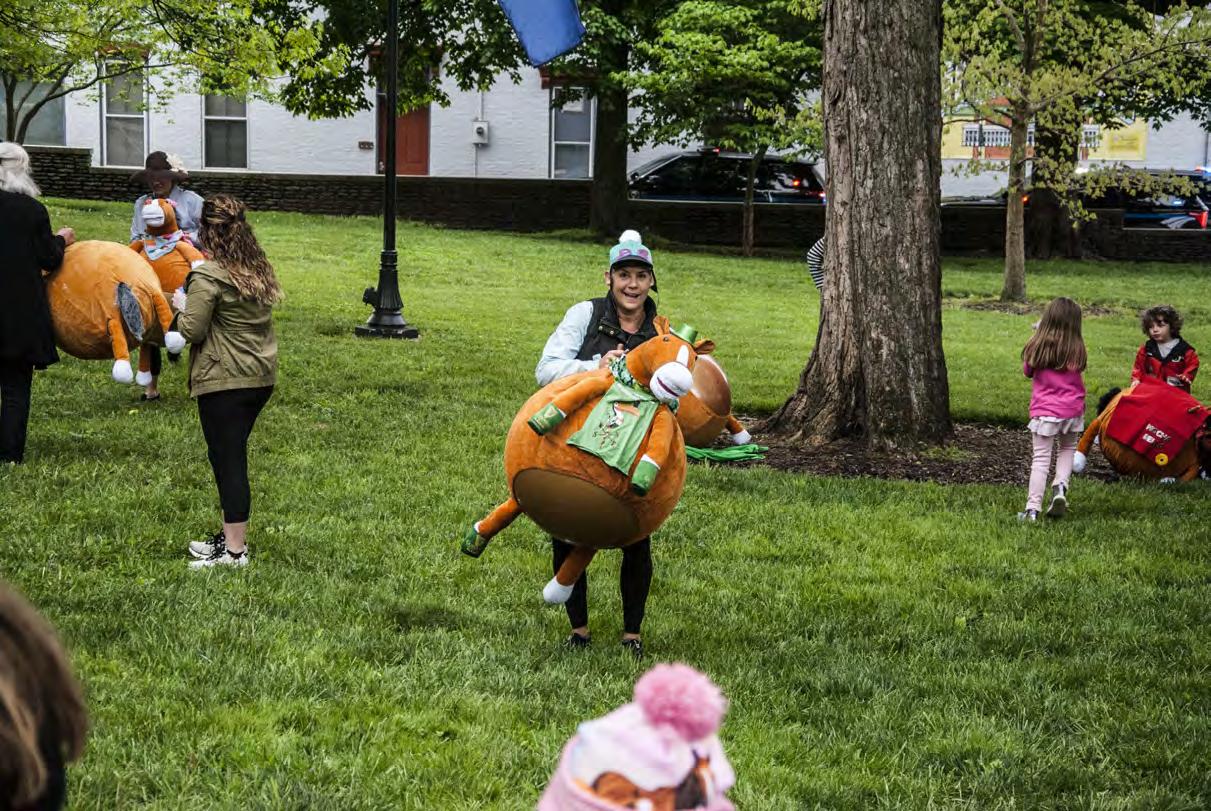

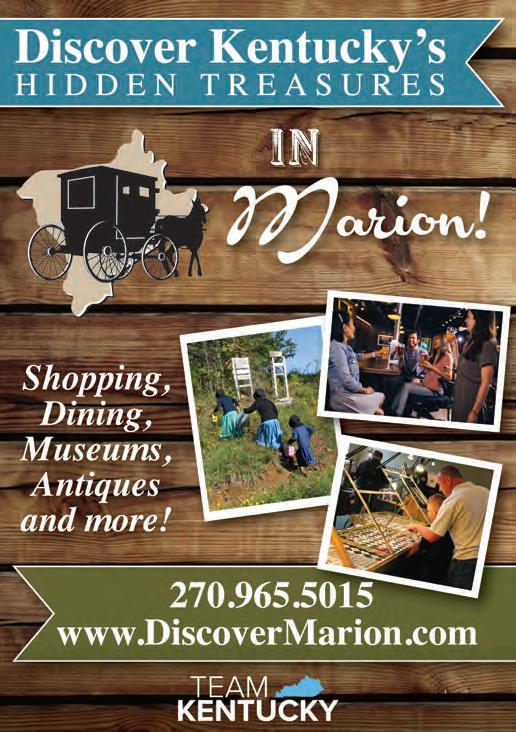






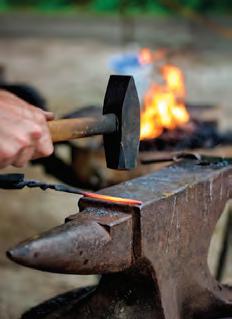


kentuckymonthly.com 43 Saturday May 6, 2023 DOWNTOWN FRAN K FO RT EAT • SHO P • EX PLORE visi tfr ankfort.com Compare all options with just one call... AUSTIN TYLER LICENSED INSURANCE REPRESENTATIVE 859.618.6443 ANDREW HORN LICENSED INSURANCE REPRESENTATIVE 859.868.4006 TURNING 65? NEED MEDICARE ENROLLMENT HELP? MEDICARE ADVANTAGE QUESTIONS? 2333 ALEXANDRIA DRIVE, LEXINGTON, KY 40504 TYLERINSURANCEGROUP.COM Questions? We have answers! WE SPECIALIZE IN Medicare Supplement Plans Part D Prescription Plans Medicare Advantage PPO & HMO Plans Dental & Vision Options We do not offer every plan available in your area. Any information we provide is limited to those plans we do offer in your area. Please contact Medicare.gov or 1-800-Medicare to get information on all of your options. Not affiliated with the U.S. Government or Federal Medicare Program. Offering Life Insurance and Medicare & Crafts Folk Arts CAPITAL OF KENTUCKY Berea Experience T H E visitberea.com empty handed. C M Y CM MY CY CMY K Berea_KyMonthly_March_3.4x4.8_HR.pdf 1 1/24/23 6:44 PM
HIDDEN TREASURE
BY GARY P. WEST
THE
Sometimes, a unique place to eat is difficult to find. One such eatery in Elizabethtown sits on the busiest highway in the city, hidden in full view.
Located at 1085 North Dixie Highway, The Café at Swope Toyota is a bona fide full-service eatery that
is an extension of the automobile dealer’s showroom. The café, which opened in 2016, features a floor-towall chalkboard menu listing the breakfast and lunch offerings.
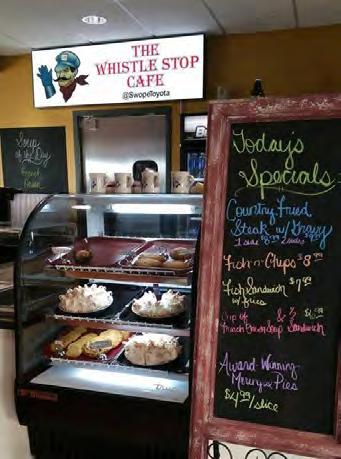

The Swope name is synonymous with selling cars in Kentucky, with brothers Sam and Bill Swope opening their first dealerships in the 1950s in Elizabethtown and Winchester. Car sales became a family enterprise. When Bill’s son Carl began planning his new Toyota dealership in Elizabethtown in 1986, general manager Kathy McCubbin was ready to push her idea of a café located just off the main showroom floor.
Carl’s brother Bob, who ran the
nearby Ford dealership for years, laughed when he recalled that Carl thought it was a crazy idea in the beginning. But Carl has since changed his mind.
“I will never build another dealership without hospitality,” Carl said. “We initially thought about a pastry display and coffee, but Kathy wanted more.”
With a background in car sales and 21 years with Swope, McCubbin found herself immersed in the restaurant business. “I went everywhere looking at small restaurants across Kentucky and Tennessee to see what made them unique,” she said. “We saw another

44 KENTUCKY MONTHLY MARCH 2023
CAFÉ AT SWOPE TOYOTA IS A DELIGHTFUL, DELICIOUS SURPRISE TUCKED AWAY IN A CAR DEALERSHIP
The Café at Swope Toyota

1085 North Dixie Highway, Elizabethtown 270.505.4966
SWOPETOYOTA.COM/ CAFE-DELI-SWOPE-TOYOTA
Monday–Friday, 7AM–3PM Saturday, 7AM–2PM Breakfast, 7–10:30AM
Swope Cars of Yesteryear Museum
1100 North Dixie Highway, Elizabethtown
SWOPEMUSEUM.COM
Monday–Saturday, 10AM–5PM
car dealership that did the dessert and coffee thing, but we decided to do it up right.”

Raised in Green County in a family of seven, McCubbin had a strong work ethic, so adding restaurant manager to her already-busy schedule was not out of her comfort zone. “Something like we have here had been on my mind for years,” she continued. “In the beginning, The Whistle Stop restaurant [in Glendale] helped us get off to a good start. We wanted an atmosphere in which the community could relax and enjoy without the pressure of thinking they had to buy a car if they came here.”
That atmosphere McCubbin
mentioned is front and center. With the café’s expansive view of Freeman Lake and a large well-positioned fireplace, visitors may forget they are in an automobile showroom.
Signage for the café is scant. Pulling into the parking lot, one may not notice the single small sign reading “Café” with a red arrow pointing to the right. Customers enter the café at the rear. “We had to follow some rules and regulations with signage for Toyota and the city,” McCubbin explained.
If you sell something good, people will find you. And so far, the local Kiwanis and Rotary clubs are finding their way once a week to the upstairs
community room to enjoy meals.
“We even had large motorcycle clubs that we put up there,” McCubbin said. “It’s also where we added an extra kitchen that takes care of the catering business that has grown here.”
The motorcycle group had been visiting the Swope’s Cars of Yesteryear Museum across Dixie Highway. In 1999, Bill Swope opened a 60-car museum of his collection of 1900-1960 classics. Admission to the museum, which has a vintage car library, is free. And yes, cameras are permitted.
“It’s our way of showing our appreciation to the community,” Carl said. Q
kentuckymonthly.com 45




































































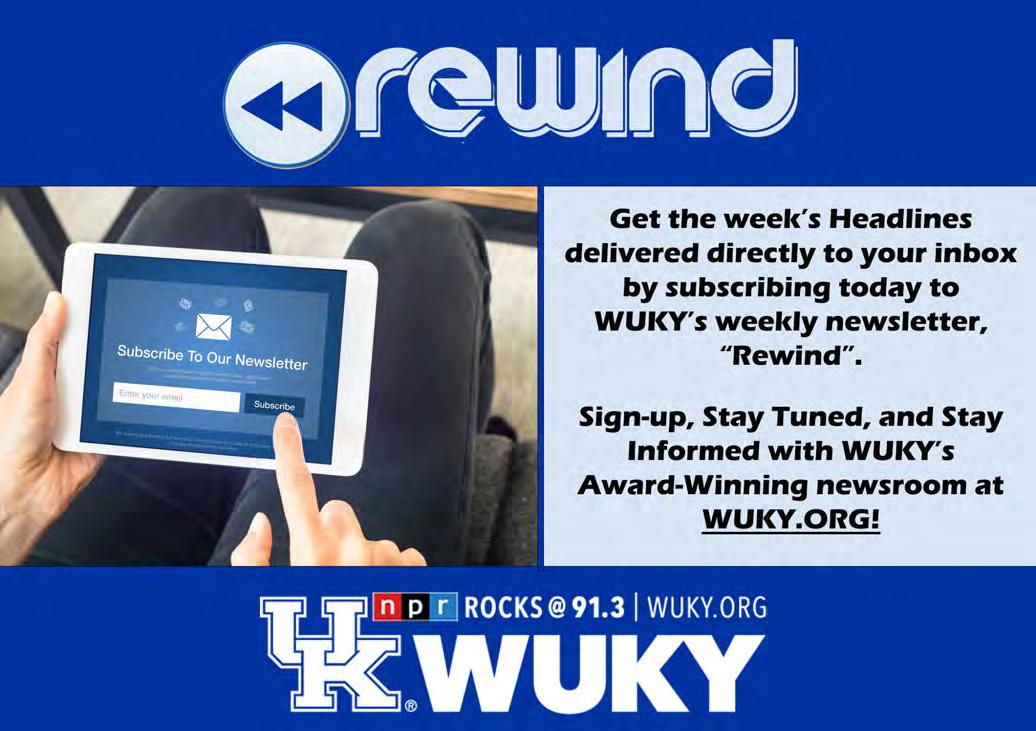
46 KENTUCKY MONTHLY MARCH 2023 Pokey La Farge May20 Hotel California May26 thegrandky.com 502.352.7469 Apr22 Roger McGuinn May5 Sons of MyStro Mar23 From Lil’ Nas X to Mozart Tribute to the Eagles
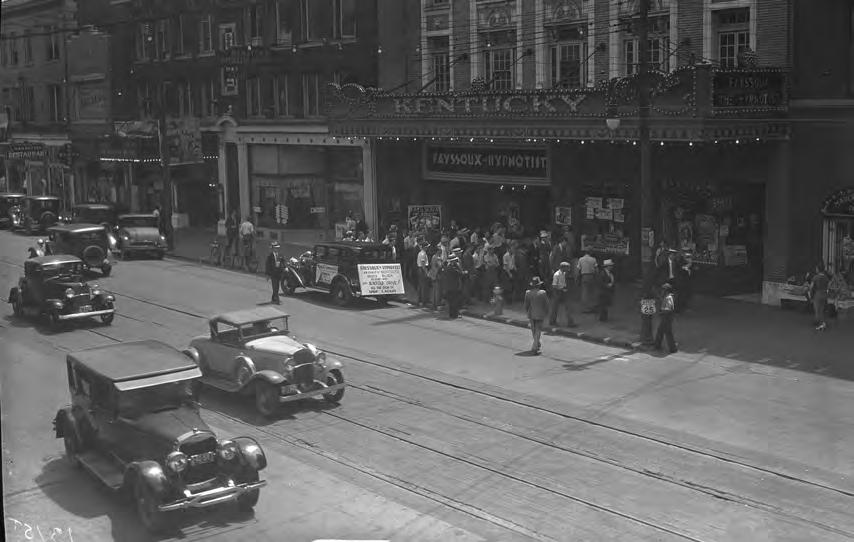
K E NTUCKY E XPLORER A section for Kentuckians everywhere … inside Kentucky Monthly. Featuring Things Old & New About Kentucky Volume 38, Number 2 – March 2023 All About Kentucky Waveland State Historic Site -- page 49 Historic Paintings of Mammoth Cave -- page 54 Bethlehem Church -- page 56 “I Remember” By Our Readers and More! The
Special
The 1901 Kentucky Derby was the 27th running of the Kentucky Derby. The race took place on April 29, 1901.
Kentucky Theatre at 214 East Main Street in Lexington. Still in operation today, the theater opened in 1922. This photo, dated May 24,1932, is courtesy of
the University of Kentucky
Collections Research Center.
Kentuckian Receives Honorary Doctorate 61 Years After Attending Murray
Mary Ford Holland was posthumously awarded an honorary doctorate from Murray State University as part of the fall commencement ceremony in December 2022.
Holland, formerly Mary Nathanial Ford, was born on May 25, 1907, in Hematite, in Trigg County. She was the sixth of 10 children born to Charlie and Cornelia Ford Mary was homeschooled by her mother and grandmother until she entered the eighth grade. She graduated from a segregated boarding school in Paducah and eventually received her teaching certificate from West Kentucky Industrial College, now West Kentucky Community & Technical College, in 1935. Holland also attended Kentucky State College, now Kentucky State University, part-time through correspondence courses, working toward a bachelor’s degree.
In the summer of 1955, at age 48, Holland transferred to Murray State College, now Murray State University, becoming the first African-American student to attend the institution. On her first day on campus, she was escorted to class by police officers and by Murray State’s then president, Dr. Ralph Woods. However, historians and Holland herself noted at the time that her presence on campus caused little to no stir among students enrolled.
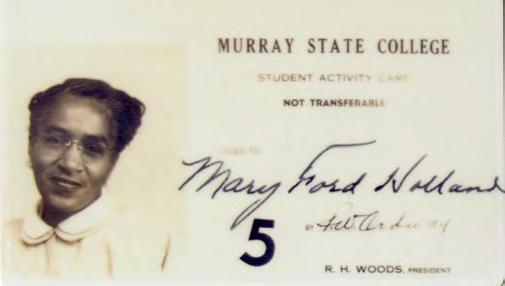
Holland received a bachelor’s degree in education from Murray State in August 1961 at age 54. Her decision to attend the college came on the heels of the Supreme Court’s Brown v. Board of Education ruling, and her enrollment officially integrated Murray State.
She was a pioneer in education and continued teaching literacy and English studies throughout Trigg, Caldwell, Christian and Lyon counties, eventually retiring as a reading specialist at Lyon County Elementary School in 1972.
Holland remained an active member of the Retired Teachers Association and was a 75-year member of Locust
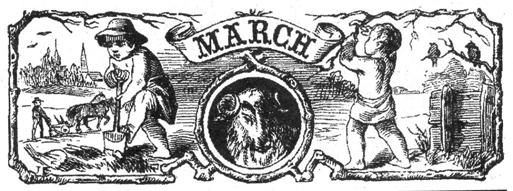
Grove Baptist Church. She received a key to the city of Eddyville in 1998.
Holland and her husband, Charles Edward Holland, who died in 1987, had no children. She passed away at age 92 in September 1999 in Lyon County.
A historical marker was placed on the campus of Murray State University by the Commonwealth of Kentucky in front of Pogue Library in the Quad. It highlights Holland’s important legacy to the university, western Kentucky and the entire Commonwealth.


48 THE KENTUCKY EXPLORER
The Kentucky state flag was authorized by an act of the legislature on March 26, 1918.
a magazine published for Kentuckians everywhere Charles Hayes Jr. • Founder Stephen M. Vest • Publisher Deborah Kohl Kremer • Editor Rebecca Redding •
One-Year Subscription to Kentucky Monthly: $25 Kentucky
Monthly
calling 1.888.329.0053.
FOUNDED 1986, VOLUME 38, NO. 2
Typographist Kentucky Explorer
Explorer appears inside each issue of Kentucky
magazine. Subscriptions can be purchased online at shopkentuckymonthly.com or by
Please send letters to Editor Deborah Kohl Kremer at deb@kentuckymonthly.com or mail to Deb Kremer, Kentucky Monthly, PO Box 559, Frankfort, KY 40602.
In memory of Donna Jean Hayes, 1948-2019
Waveland State Historic Site: The Bryan Family Home
By Susan Miller, author and historical interpreter
The Waveland mansion sits gracefully atop a small knoll and is considered one of the finest examples of Greek Revival architecture in Kentucky. It was completed in late 1848 by Joseph Bryan.
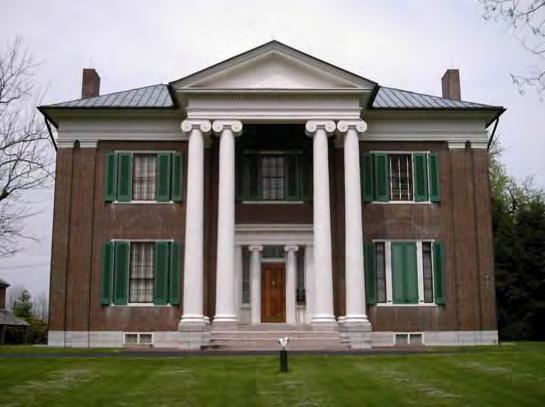
The name Waveland described the hemp and grain crops that waved in the breezes on the once-vast plantation. At one time, the property in southern Fayette County and northern Jessamine County spanned nearly 2,500 acres.
The Waveland line of the Bryans began with Daniel Bryan (1758-1845), who was the son of Capt. William Bryan, the founder of Bryan Station in northern Fayette County, and Mary Boone Bryan Mary was the sister of the frontiersman Daniel Boone
Daniel Bryan built a stone house at the exact site of the Waveland mansion circa 1790. Daniel was a frontiersman, gunsmith, farmer, businessman and historian. He established a thriving community on his plantation. He had a gunsmith shop that employed as many as 25 men. The Bryan rifles had an artistic quality that no other rifles possessed. Daniel had a gristmill, blacksmith shop, distillery and paper mill. He founded Providence Baptist Church in 1817 and founded a female seminary.
Daniel’s youngest son, Joseph Bryan, inherited Waveland. Joseph built the mansion “to please his father,” according to a letter written by his son Elijah in 1845. Joseph tore down the old stone house and erected the large opulent mansion. It is said that Joseph used materials acquired from the plantation—solid walnut doors, ash flooring, cherry furniture and bricks from clay deposits. The house was built with 14-foot high ceilings, which made the rooms cooler in the summer.
Joseph Henry Bryan, the youngest of Joseph Bryan’s five children, inherited approximately 300 acres of the remaining Waveland property. While he owned Waveland, he established it as one of the premier Thoroughbred and trotter farms in Kentucky. Joseph Henry built an equine racetrack across from the mansion, where he and other businessmen would gather for public racing. However, in less than seven years, Joseph Henry had to auction off the plantation to pay his bills.
The plantation was purchased by the Hullet family in 1894. James Allen Hullet was a tobacco farmer. This family owned the farm for more than 60 years.
In 1956, the Commonwealth of Kentucky bought the property for use by the University of Kentucky College of Agriculture as experimental farmland.
In 1957, Waveland mansion and the 13 acres surrounding it became the Kentucky Life Museum, depicting life from the pioneer days to the Civil War. The museum was created for the collection, preservation and display of Kentucky relics and artifacts that have had some bearing upon the way in which Kentuckians have lived throughout the years. The master plan called for an eventual restoration of the village that existed at Waveland during Daniel Bryan’s lifetime.
Dr. Hambleton Tapp, a well-known history professor at the University of Kentucky, was given the assignment of creating the museum. He asked the citizens of the Commonwealth to donate family treasures. Tapp collected a massive number of artifacts, which are seen in the mansion and slave quarters today. Many Bryan family treasures were returned to Waveland as gifts from the Bryan family.
In 1971, UK deeded Waveland to the Kentucky Department of Parks. Currently, Waveland State Historic Site includes the mansion, decorated in antebellum style, and outbuildings, which include the ice house, a two-story brick building that was the slave quarters, and a smokehouse.

The Bryans were wealthy due to the hemp grown and processed at Waveland. It was a labor-intensive crop. Most of the enslaved persons were involved in all agricultural tasks. Others served the Bryans in the mansion.
Today, Waveland hosts Tea Tuesday events and special holiday and private teas. It is the site of many weddings that use the barn and grounds for the celebrations. Waveland presents a wonderful immersive theater production of Dickens’ A Christmas Carol in December. Ghost hunts, history weekends and the Waveland Art Fair are enjoyed by thousands of park guests.
WAVELAND STATE HISTORIC SITE
225 Waveland Museum Lane, Lexington 859.272.3611
Tours offered April-October, Wednesday-Saturday parks.ky.gov/lexington/parks/historic/waveland-state-historic-site
March 2023 49
Daniel Boone came to Kentucky for the first time in 1767.
Waveland’s Treasures by Bob Willcutt and Susan Miller is available at bookstores. Signed copies can be purchased at Waveland.
“I Remember” By Our Readers
Meeting Queen Elizabeth II … Sort of

We arrived early, and while strolling in the paddock, we spotted Peggy Clemons, a Frankfort native and Pat’s former co-worker. Peggy had made the trip from her new home in Maryland to Keeneland also in hopes of a glimpse of the Queen. We could at least say, “We were there when the Queen of England visited!”
By Don J. Dampier, Georgetown
On Sept. 8, 2022, the world was saddened by the death of Elizabeth II, Queen of the United Kingdom, at age 96. She served on the throne 70 years and was the longest-reigning monarch in Great Britain’s history.
On Oct. 11, 1984, at Keeneland Race Course’s fall meet, Queen Elizabeth visited Kentucky to view the races and officiate with the trophy presentation of the first Queen Elizabeth II Challenge Cup, a stakes race for 3-year old fillies, at a distance of 1 1/8 miles on turf.
My wife, Pat, and I occasionally enjoyed spending an afternoon at Keeneland—both the spring and the fall meets. But on that beautiful October day, Pat dressed in her classy attire and I in my blue blazer and sporty tie with foreknowledge of the Queen’s visit. We had made a special effort to attend in hopes that we might get a distant glimpse of British royalty. It turned out to be much better than expected with a lasting, serendipitously eventful memory.
As we were chatting to catch up, Keeneland security came through to clear the paddock to make way for the entry of the Queen. As we were rushed through the gate with an unobstructed view of only a few yards from the Queen, we were surprised to see that Peggy was still where we left her. Amazingly, the Queen and her entourage had stopped to speak with Peggy!
Queen Elizabeth: “My, what an attractive young woman, what is your name?”
Peggy: “Thank you, Madam Queen, my name is Peggy.”
Queen Elizabeth: “Oh! My first horse was a Shetland pony, named Peggy.” After this brief congenial exchange and a slight genuflect from Peggy acknowledged by a nod, the Queen moved on. When security opened the gate, we rushed to Peggy, arriving only a couple of steps before our threesome was suddenly circled by television cameras, with reporters from area stations lining up for interviews. As each finished interviewing Peggy, they turned to me, assuming that I had spoken with the Queen, but my answers were, “Queen Elizabeth is an elegant lady, and we in the Commonwealth of Kentucky are honored by her presence at Keeneland for the Queen Elizabeth II Challenge Cup.”
After all of the TV cameras left, another reporter who had stood on
the sidelines approached me, microphone in hand, with his introductory comment, “I don’t know who you are, but you must be someone famous. May I interview you?” This was Mark Hebert, who would become a longtime WHAS-TV state government political journalist in Frankfort. He later consulted with me often on state government issues and became a good friend. Eventually, he was inducted into the Kentucky Journalism Hall of Fame.
Well, we did not meet the Queen face-to-face, but at that October 1984 fall meet, we were closer to her than most of her British subjects ever were … sort of!
But Does It Lower Cholesterol?
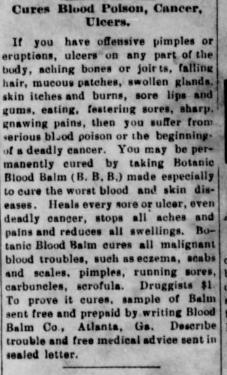
4 THE KENTUCKY EXPLORER 50 THE KENTUCKY EXPLORER
Send your memory in today! The town of Owensboro was called Yellow Springs when it was established in 1817. Send
to
deb@kentuckymonthly.com or mail to Kentucky Monthly, Attn:
Kremer,
memories
Deborah Kohl Kremer at
Deb
P.O. Box 559, Frankfort, KY 40602.
Queen Elizabeth with Keeneland’s thenpresident Ted Bassett, left, Oct. 11, 1984.
Item from the Breathitt County News, March 9, 1906.
Dayton, Kentucky: Coach Wooden’s First Stop on the Path to Become The Wizard of Westwood
By Tina Neyer, Bellevue
Famed basketball Coach John Wooden might best be remembered for his amazing run out West. In a 12-year period, he led the University of California, Los Angeles to 10 NCAA men’s championships, seven consecutively. He coached the likes of Kareem Abdul-Jabbar, Bill Walton and Gail Goodrich, but his legacy began in Dayton, Kentucky. There, he learned lessons that later translated into a program called the Pyramid of Success that would help individuals learn to be the best version of themselves.
In 1932, fresh out of Indiana’s Purdue University, Wooden accepted the job of high school coach with only $2 to his name. The bank that held his life savings—$909.25—had failed just days before he and his new bride, Nellie, left their hometown of Martinsville, Indiana, for Campbell County, Kentucky.
The young coach and teacher wore many hats in his time at Dayton High School. He was hired to teach English with an annual salary of $1,500. As athletic director and football, baseball and basketball coach, he received $300 additional pay. He once said that
Ohio & Kentucky Railway
By David Morse
The Ohio & Kentucky (O&K) Railway was a short line that ran through Breathitt, Wolfe and Morgan counties. The line started at O&K Junction, 1.37 miles west of Jacksonville on the Lexington & Eastern, to Cannel City in Morgan County. It was owned by the Kentucky Block Cannel Coal Company. The line was built to haul Cannel coal and timber. Construction started in October 1899, and the 26 miles to Cannel City were completed on June 10, 1901.
After more coal deposits were discovered in Caney Valley and logging operations commenced on the Licking River, a 12.8-mile line was built from Cannel City following Caney Creek to the Licking River. This line was owned by the Caney Valley Railway, which was owned by the O&K. Construction of the Caney
he felt overpaid as a coach, especially after an incident with a football that digressed into a fist fight. After that altercation, he took courage through the belief that there is nothing stronger than gentleness. He learned his limitations and never coached football again.
John and Nellie rented a home a few blocks from the school. He likely walked back and forth after long hours at work. During a time when options ran thin, savings were lost during the Depression, and opportunity rarely knocked, Wooden began his journey toward greatness. He found value in what appeared to be failure and learned lessons that would serve him in 40 years of coaching and teaching.
During the first season he coached the Green Devils, the team headed to his hometown of Martinsville to face the Martinsville Artesians, a team that as a player he had led to the Indiana state championship in 1927 before going on to earn three All-American titles at Purdue between 1928-32. Before a packed gym, the Green Devils lost 27-17. It marked the only losing season Wooden would have in his career. He said the lessons learned in
Valley Railway started in 1910 and was finished in 1911.
Another short line, the 3.5-mile Caney & West Liberty Railroad, was built from Cannel City to Piedmont to serve the mines of the White Oak Cannel Coal Company. After filing for bankruptcy, the Caney & West Liberty Railroad was reorganized as the Caney, Piedmont & Morehead Railroad. The CP&M ended operations in 1907.
There were two tunnels on the O&K line—the Hampton Tunnel at the Breathitt and Wolfe County line and the Caney Tunnel between Adele and Cannel City.
The coal and timber finally played
that first year of coaching could be summed up in the fact that patience is the most valuable asset for a leader. He came to understand that a strong foundation in sports and, more importantly, in academics builds a strong and winning team and student.
In 2004, Wooden collaborated with Steve Jamison to write a book titled My Personal Best. He wrote, “I believe that in my first year at Dayton High School, I learned more about how to work with people and about myself— my temper, stubbornness, impatience, and desire for immediate results— than any of the 39 years of coaching to follow.”
Wooden led the Green Devils to a disappointing six wins and 11 losses in the 1932-33 season. The following year, the team recorded 15 wins and only three losses.
The old school has been reimagined into apartments. They say the floor that Mr. Wooden coached on is still intact, the emblematic green devil painted into the wood, perhaps a bit faded. But to some, especially in the river town of Dayton, basketball’s legacy is rooted in the history of the Wizard of Westwood.
out, and on Nov. 1, 1933, the O&K made its last run. The line was then scrapped.
The photo below shows Ohio & Kentucky 4-4-0 American type locomotive No. 18 at the Georgia Car & Locomotive Company shops in Atlanta. The No. 18 was built in 1870 for the Georgia Railroad & Banking Company as their No. 37 and named L.M. Hill. She was sold to the O&K in 1910 and converted from a wood burner to a coal burner. She was found to be underpowered for the grades on the O&K and was traded to Louisville, New Albany & Corydon.
Cannel coal also is known as candle coal and was once known as boghead coal. It is a form of coal that also is considered an oil shale. It was used to make jewelry and found great favor as fuel for coal-burning fireplaces. It also was used to make coal oil or coal kerosene for lanterns and lamps. At one time, there were 55 companies in the United States that made coal oil.

March 2023 51
Bullitt’s Lick Settlement, in present-day Bullitt County, was founded as an animal salt lick in 1779.
The George Rogers Clark Federal Monument
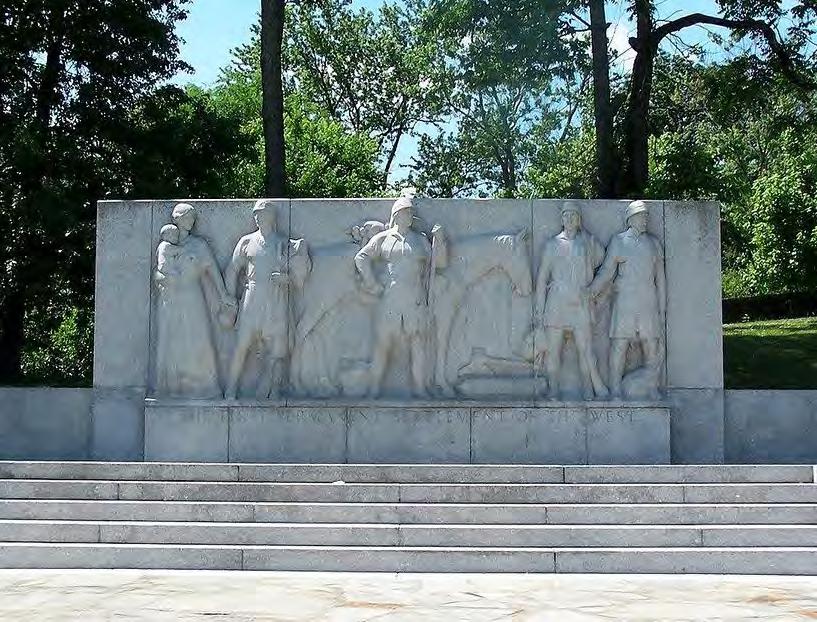 By Bobbi Dawn Rightmyer, Harrodsburg
By Bobbi Dawn Rightmyer, Harrodsburg
George Rogers Clark was the liberator of Kentucky and one of the Commonwealth’s genuine heroes.
The Pioneer Memorial Park Monument commemorating George Rogers Clark was commissioned by the Kentucky Pioneer Association, a local group of Harrodsburg citizens. On March 3, 1931, the 71st Congress passed a bill appropriating $100,000 for the monument. It would be erected by the United States Department of War. The monument was a way for the U.S. government to recognize the important part Kentucky played in building and preserving the nation. Kentucky Gov. Flem D. Sampson dedicated the monument site.
The First Settlement of the West, the name of the monument, was conceived by sculptor Ulric Ellerhusen and architect Francis Keally. LePoidevin & Company of New York was awarded the general contract. On Armistice Day, Nov. 11, 1933, the cornerstone was laid by Sen. Alben W. Barkley during a ceremony attended by Gov. Ruby Laffoon
On Jan. 12, 1934, work on the federal monument was halted for three weeks because carvers feared their dull tools would break the granite stones. The carvers demanded a toolsmith on the grounds to sharpen tools, so an expert toolsmith, George Webber of Louisville, was found, and the carving resumed. Webber established his shop in a shed fronting the carvers’ enclosure and began sharpening tools immediately.
During February, sodding, planting and landscaping began around the larger monument. F.C. Byers of Lexington’s Hillenmeyer Nurseries was in charge of landscaping. He followed designs made by Armistead Fitzhugh, a landscape architect from New York City. The trees and shrubbery would form the background and setting for the monument.
The 30-foot-long, 12-foot-high memorial was completed on June 12, 1934. It is composed of three granite blocks cemented together so that it appears to be one huge stone. The monument divides naturally into three parts. The central section depicts Clark and weighs 23 tons. The right section symbolizes youth and age, with an older man depicting famous frontiersmen such as James Harrod and Daniel Boone. The left section shows a frontier farewell and is symbolic of family life. These stones weigh 17 tons each. The granite stone inlay map on the walking platform in front of the monument shows the pioneer routes involved in Clark’s campaign of the Northwest Territory.
On Nov. 16, 1934, President Franklin D. Roosevelt came to Harrodsburg to dedicate the Pioneer Memorial. This was Harrodsburg’s greatest day and its proudest celebration. All roads leading into town were choked with traffic. Special trains and buses had been arriving for several days prior, swelling the population to numbers that have never been matched since. The President and First Lady Eleanor Roosevelt arrived by train and were welcomed by a town decorated with flags and bountiful red, white and blue bunting.
The monument’s dedication was national news, with the president’s speech printed on the front page of The New York Times. It marked the culmination of a decades-long effort to bring tourists and attention to Harrodsburg. At a time when Harrodsburg’s population was around 4,000, an estimated 60,000 people filled the park for the ceremony.
In his remarks, President Roosevelt called for a renewal of the spirit of the American forefathers to face the challenges of the Great Depression. He described those attending as “the pioneers of 1934.” He proclaimed, “We, too, are hewing out a commonwealth—a commonwealth of the states which we hope will give to its people, more truly than
6 THE KENTUCKY EXPLORER 52 THE KENTUCKY EXPLORER
Established on March 16, 1801, Wayne County was named for “Mad Anthony” Wayne, a general in the Revolutionary War.
any that has gone before, the fulfillment of security, of freedom, of opportunity and happiness which America asks and is entitled to receive.”
Although preparations for this one day took months of work and hundreds of people, President Roosevelt’s speech lasted 10 minutes. He was quickly escorted back to the waiting train and his return trip to Washington.
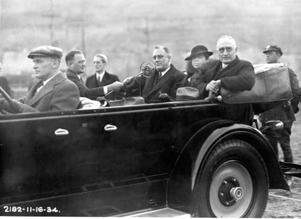
The monument’s plaque reads: “To that hero and patriot – George Rogers Clark –1752-1818 – Whose foresight, courage and fortitude gave to his country the vast territory lying between the Ohio River and the Great Lakes.”
The original artist’s rendering and the plaster molds from the project were donated by Ellerhusen to the Filson Historical Society in Louisville. The chair in which President Roosevelt sat to deliver his address is on display at Harrodsburg’s historic Beaumont Inn, and there is a permanent marker at Old Fort Harrod State Park to indicate Roosevelt’s place on the platform.
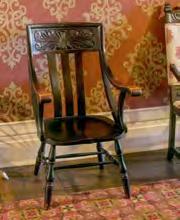
President Roosevelt’s Dedicatory Address
Senator Barkley, Governor Laffoon, and, after what your Senior Senator has said, I think I can say, “My Fellow Pioneers”:
We, pioneers of 1934, are come together today to honor the pioneers of a century and a half ago. On my journey hither I have been reading once more of those thrilling days which saw the first peopling of these fair lands beyond the mountains. It was the perfect moment which destiny offered to our forebears to create these United States.
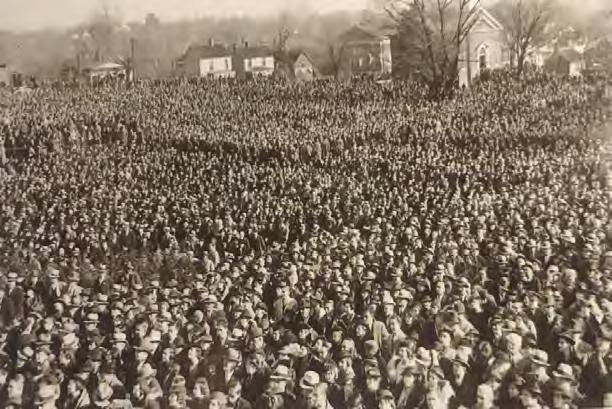
It has seemed to me in reading history that Harrodsburg can lay claim to having been the scene of more historical first things than any spot I have ever known, and as you know, I am very much in favor of first things. It seems not enough that this delightful and historic place was the first permanent settlement well beyond the mountains; that there were here the earliest pioneer homes; that here came the first school teacher and the first doctor; that here was the first court of the West. That seems not enough; to this you must add many other firsts— the first corn raised in Kentucky, the first peach trees and apple trees planted, the first wheat fields, the first grist mill and, perhaps most important of all, the first spinning wheel.
That is why I am happy that, in addition to paying tribute to the memory of George Rogers Clark who led his men from here to his great invasion and preservation of the inland empire for the United States, you are also honoring the men and women who made his expedition possible and who followed him with the permanency of home building.
It has come to be a generally accepted rule of civilized Nations that mere discovery of new lands conveys no sovereignty; and, indeed, that mere conquest conveys but little better title. It is, after all, only the peopling of the wilderness which gives permanency to the form of an ordered society.
There is a very definite analogy between those days and our days. Upon the pioneers of these great stretches of the Central West were forced new activities because of the circumstances of their surroundings. They were compelled to hew out a new path —a path that was
dependent not on the ax and the rifle alone, but upon their ability to govern themselves in new ways as well.
To most of the pioneers the necessities of the new life called for efforts and experiments to which they had not been accustomed in their earlier years in the more ordered civilization of the Atlantic seaboard. For them, survival itself demanded immediate and new action.
I have called those of us who are here today “pioneers of 1934.” And I mean everything that that word “pioneer” implies. We, too, in these latter years throughout the length and breadth of our land have come to a realization of the pregnant fact that the accustomed order of our formerly established lives does not suffice to meet the perils and the problems which today we are compelled to face. Again, mere survival calls for a new pioneering on our part.
Some portion of the blood of the Colonists and the pioneers who worked their way, through generations, across the mountains and across the plains and again across the mountains until they came to the Pacific, is present in very large part in the veins of millions of our people today and, in even greater part, in the veins of those whom I see before me today. More than that, the example and the spirit of those earlier Americans are present in the mind and the heart of all our population.
The events we celebrate today were so vital in the extension of the new Nation, that it has been thought proper for Congress to commemorate them not only in the spirit of gratitude, but in the spirit of emulation, as an example to guide us in the conquest of new frontiers of the spirit, frontiers of the spirit that are neither physical nor geographical.
We are carrying on, we shall carry on the purposes of these men and women of Harrodsburg. They were hewing out a Commonwealth, and I like that word “Commonwealth.”
All over this Nation we are hewing out a Commonwealth—a Commonwealth of the States which we hope will give to its people, more truly than any that has gone before, the fulfillment of security, of freedom, of opportunity and of happiness which America asks and which America is entitled to receive.
Morehead Normal School, now known as Morehead State University, opened in 1887.
March 2023 53
Above, the crowd at the dedication; far right, the President and First Lady arrive in Harrodsburg; right, the chair Roosevelt used during his address.
Photos courtesy of Bobbi Dawn Rightmyer
Historic Paintings of Mammoth Cave

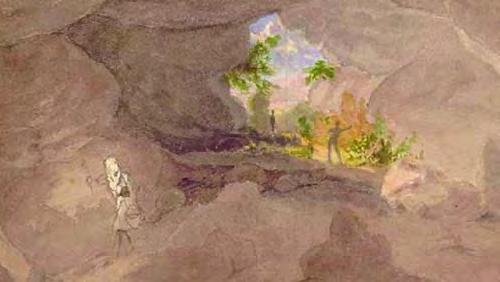
Nature’s Underground Art Gallery
By Bob Thompson, Mason
Mammoth Cave has always been considered a work of art. One of nature’s grandest curiosities, the cave has been explored by many. Some wrote detailed descriptions, while others made drawings of its vast interior, but only a few ever attempted to create paintings of the cave. These masters of art had a desire to present the cave as one of the most remarkable scenes in nature.
Landscape painting was the first American art to be called a national style. Many landscape artists relied on close observation and natural light to create believable views of the world around us. In a cave, this can be more difficult because there is no natural light. The only light available consisted of oil lamps, burners and torches. Amazingly, artists were able to bring out the most striking details of the cave. The colors used in the paintings were vivid and gave remarkable definition to the cave’s interior. Paintings of the cave show the vast darkness as well as the limited reaches of artificial light. In all, the artists’ paintings appear to bring out Mammoth Cave’s most hidden and well-guarded secrets to the world.
The following distinguished landscape artists made
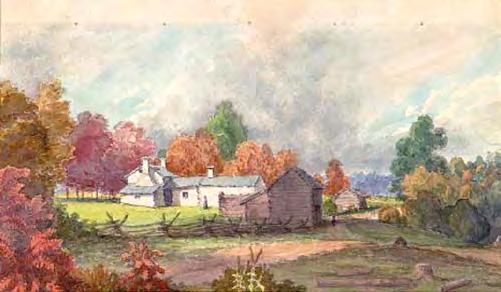
sketches and painted in the depths of Mammoth Cave. n Marie-François-Régis Gignoux (1816-1882) was a French landscape painter who was active in the United States from 1840-70. Gignoux visited Mammoth Cave in 1843 and painted a view of the cave entrance and the extensive Rotunda. At the bottom left is a party of four people. On the left is probably cave guide Stephen Bishop, with his torch-throwing stick and supplies for the cave trip carried around his shoulders. To the right of the guide is the artist, Gignoux (wearing the hat) and his tools of the trade to paint the underground wonder. To the right of the artist is Gignoux’s assistant seated in front of a rock with the artist’s selection of colors. Above the assistant, climbing up a ladder, is another cave guide with a number of lamps to help illuminate the darkness. What looks like a roaring fire actually is a number of the open-flame lamps brought together, which put out a great deal of smoke.
n Robert Montgomery Bird (1806-1854) was a 19th century author from Philadelphia. He gained literary acclaim in Philadelphia, New York and Boston as well as overseas. Bird complemented his literary career with drawings, photography and music compositions. He
54 KENTUCKY MONTHLY NOVEMBER 2020
54 THE KENTUCKY EXPLORER
Adair County is named for John Adair, who was Kentucky’s eighth governor, serving from 1820-24.
Left, the entrance to Mammoth Cave from inside the Rotunda by Marie-François-Régis Gignoux, ca.1843 [Courtesy of NewYork Historical Society]; top right, watercolor of view from the entrance by Robert Montgomery Bird, 1833 [Courtesy of Robert Montgomery Bird Collection, University of Pennsylvania]; above right, the old cabin (Gatewood’s house) at Mammoth Cave, the earliest known representation of lodging for tourists at the cave, by Robert Montgomery Bird, 1835 [Courtesy of Robert Montgomery Bird Collection, University of Pennsylvania].
visited Mammoth Cave in June 1833 and October 1835 and produced three watercolor paintings as well as the first known drawing of the cave entrance and the earliest known drawing of lodging for tourists at Mammoth Cave.


n Danish-American artist Ferdinand Richardt (18191895) primarily painted landscapes, castles, manors and tourist attractions. Mammoth Cave National Park has in its collections 16 Richardt original cave sketches that were donated to the park by a descendant of Richardt’s. Included are two original sketches of “Echo River.”
Richardt described “Echo River”: “In this picture are seen two boats with visitors [and a dog], the guides [Mat and Nick Bransford] standing in front of their respective boats. The one in the background is illuminated by the lamps, which are used in the expedition and are placed in the middle of the boat, and the other in the foreground stands in the full blaze of a large burning pile on the right hand side, which throws its reflection in the water. This scene is one of the grandest that can be imagined, and the effect of the light in the darkness above is wonderful. A young man who is standing in the middle of one of the boats is represented in the act of raising his voice to call forth one of those curious and melodious echoes for which this river is celebrated. It may interest many to know that

this river abounds in a kind of small fish, something of the shape of a whale and who are entirely devoid of the sense of sight.”
n In 1857, Clement Reeves Edwards (1820-1898) moved to Bowling Green and set up a studio where he not only painted portraits but also was a photographer. In August 1858, he visited Mammoth Cave to sketch and paint the famous Bridal Chamber in the cave. The oil painting is in the collections of the Kentucky Library and Museum on the campus of Western Kentucky University in Bowling Green.
n Carolus (Carl or Carlos) Brenner (1865-1924) was the son of the prominent Louisville artist Carl Brenner. In August and October of 1882, Brenner went on a “sketching trip” to Mammoth Cave to start and finish a large canvas of the entrance of the cave. His October trip lasted two weeks. By 1890, the oil painting was finished and on exhibit in Louisville. It is in the collections of the Filson Historical Society in Louisville and can be found on the first floor library/south parlor of the Ferguson Mansion.
The depth and beauty of each one of these exceptional pieces of art are a sight to see. If you ever get the opportunity to see any of these historic drawings and paintings on display, check them out!
Kentucky ranks 37th in land size, with 39,732 square miles.
Top, Echo River in Mammoth Cave by Ferdinand Richardt, 1867 [Courtesy of Hindman Auctions, Cincinnati, Ohio); above left, the Bridal Chamber, depicting a wedding at the Bridal Altar formation in Mammoth Cave, by Clement Reeves Edwards, 1858 [Courtesy of Special Collections Library, WKU, Bowling Green]; above right: Natural Entrance at Mammoth Cave by Carolus Brenner, 1890 [Courtesy of Filson Historical Society, Louisville].
Bethlehem Church
Dates Back to 1836
By James W. Miller Diamondhead, Mississippi
My great-great-great-grandparents Joseph and Nancy Miller established a vibrant community church in rural Kentucky.

Joseph came to Kentucky at age 12 in 1803, when his parents, John and Ruth Bailey Miller, brought their eight children from Berkeley County, Virginia, down the Ohio River. That was the same summer that Meriweather Lewis and William Clark took the route to launch their expedition to chart the Louisiana Purchase.
John and Ruth settled in Nelson County near the present-day village of Fairfield. Carving a new life out of what was still wilderness took hard work but was greatly enhanced by older children who helped with growing crops, raising livestock, and doing household chores. In 1804, Alexander was 20, Esther 18, Elizabeth 17, John Harrison 15, Joseph 13, and Ruth 11—all old enough to contribute significantly.
Within two years after buying his first property, John made additional land purchases that more than doubled his total acreage. On Aug. 1, 1804, John paid 450 pounds to Samuel Payne and his wife, Mary, for 222 acres “lying on the waters of Coxes Creek” and adjacent to the Miller property. On July 20, 1806, John paid William Boyd 25 pounds, 10 shillings for an additional 20 acres “on the East
fork of Coxes Creek, beginning at a Buckeye stump.”
John and Ruth set a good example for their children, and in 1821, son Joseph and his wife of three years, Nancy Montgomery—my third great-grandparents—bought their first parcel of land. Joseph paid $1,028 for the 80-acre tract “in the County of Shelby on the waters of Cane Run, a branch of Floyds Fork, adjoining lands of Robert Gilliland and James Taylor.” The tract was described in the language of the day as “beginning at a poplar and fallen beech on Duncan Rose’s original line and thence with the same north 20º west 119 poles to a beech and elm thence south 70º west and 121 ½ poles east 120 poles to two beeches and thence north 70º east 128 8/10 poles to the beginning.”
By 1836, the prolific couple had expanded their household to eight children, but that year was important for another reason. On Jan. 20, 1836, Joseph and Nancy conveyed a portion of their farm to establish the Cumberland Presbyterian Church, later known as Bethlehem. A building was constructed, and services were held, probably once a month or whenever a traveling preacher was in the vicinity, which was common practice at the time.
Joseph Miller was 53 and a leading member of the church when the congregation hired its first full-time pastor, Rev. Laban Jones, who came from Mercer County in 1844.
“The man with no imagination has no wings.” Muhammad Ali
56 THE KENTUCKY EXPLORER
The Bethlehem congregation included the author’s great-grandmother, Emma Dean Walters Miller (the tall lady in black, to the left of the door), and his grandfather, Chester Miller (the tall boy in front with tie, to the right of the door).
For the next half-century, the Cumberland Presbyterian Church saw new generations of Millers take leading roles in the congregation. The church was part of the Kentucky Presbytery until 1898, when it joined the Louisville Presbytery. The church stopped reporting to the Louisville Presbytery by 1906, when the Louisville Presbytery split and joined the Presbyterian Church U.S.A. in 1909. That probably was the time Cumberland changed its name to Bethlehem, the name I remember as the first church I attended in the 1950s.
At that time, my grandfather Chester was the church treasurer and grandmother Bessie Boswell Miller was the church secretary. Dwindling membership compelled the church to convene once a month, and in about 1956, operations were suspended. Bessie kept the church records until her death in 1965. When the family was cleaning out her house, I saw papers that contained membership rolls dating back to the church’s founding.
My father Charles made some inquiries at that time and was instructed to send the documents to Danville. My recollection is they were sent to a bank, but I do not recall if that was because someone at the bank was affiliated with the applicable presbytery or with Centre College, located in Danville. Centre was founded in 1780 by Presbyterian immigrants and still maintains an affiliation with the denomination. That is where we lost the trail of the Bethlehem Church records.
My brother, former state Rep. Jerry T. Miller, and I have an active interest in the cemetery. Several years ago, I recorded a census of 104 gravestones still standing today. Four generations of Millers are buried there, along with
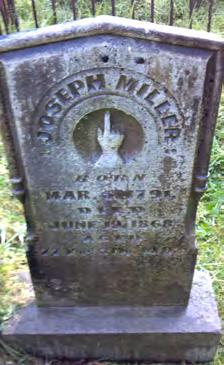
other parishioners named LaMaster, McKinley, Casey, Walters, Flynn, Conn and Moore
Four stones nearest to where the church building stood are enclosed by an iron fence that surrounds the graves of the Jones family: The Rev. Jones; his wife, Rachel A. Jones; their son, Dr. John P. Jones; and Leonard Jones, who probably was Laban’s brother. Several paces away is a similar iron fence that encloses my third greatgrandparents, Joseph and Nancy Miller, who are surrounded by their children and grandchildren. Not far away is the stone of my grandfather’s brother, who died in 1920. My most vivid memories of Bethlehem include the sanctuary of five or six rows of pews with an aisle down the middle and a pulpit resting on a slightly raised 8- by 10-inch platform, a painful reminder of the first paddling I received for my decision when I was 4 years old to walk up and join the pastor on the platform while he was preaching. The pastor told my parents that I was fine, but after we arrived home, my father was not as understanding.
The church building burned shortly after the congregation shut down. The church property is privately owned today, although the cemetery survives. The last burial there was believed to have been in 1987. My brother helps to maintain the cemetery now, but, as with the case of other abandoned cemeteries around the state, its future is uncertain.
James W. Miller is the author of Integrated: the Lincoln Institute, Basketball and a Vanishing Tradition, published by the University Press of Kentucky. He can be reached at jwmilz@bellsouth.net.
It Beats Waiting for a School Bus
In this 1920s photograph, Giles and Willie James begin their daily journey to the Bethlehem Grade School by hitching their pony Jeff to the buggy and climbing aboard. Jeff, spent most of his time at the school with the boys. At the time, many schools had stables on the grounds for the horses and ponies the students used for transportation. [Photo courtesy of Dorothy Watkins and the Henry County Historical Society]
CLASSIFIED AD
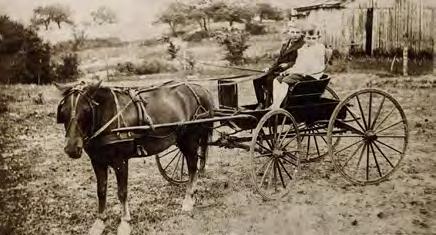
Subscribe to Kentucky Monthly Ten Issues per year: $25 Call us today! 1.888.329.0053 shopkentuckymonthly.com March 2023 57 The Virginia county of Kentucky was created in 1776. WANTED TO BUY: All types of antiques and collectables. Top prices for gold, silver and costume jewelry. Scrap gold. Gold and silver coins. Wrist and pocket watches. Collections. Early post cards and fountain pens. Civil War swords and other military items. Vintage toys. Pocket knives. Lighters. Old eye glasses. Pottery and stoneware. All types of railroad items. Advertising signs. Handmade quilts. Marbles. Jars. Much much more. Complete and partial estates. Call Clarence, buyer for more than 30 years, at 606.531.0467. (F-D) Reach 120,000 readers with classified advertising available in Kentucky Explorer. Classified ads $50 per issue (up to 25 words). Contact Deborah Kohl Kremer at deb@kentuckymonthly.com
Gravestone of the author’s great-great-greatgrandfather Joseph Miller.
by Bill Ellis
Borders, Boundaries and Barriers
Ihave always been fascinated by maps. When I was a little kid, a map of the United States or the world almost took my breath away. The country was so large, and the world monstrous to me. I have been fortunate to travel to all 50 states, all the Canadian provinces, and some foreign countries, including New Zealand for a Fulbright Scholarship to Massey University.
If you look at a map of Kentucky, you will notice that we are bounded by the Ohio, Mississippi and Big Sandy rivers and tributaries, along with borders determined by surveyors, politicians and other factors. There is the famous Simpson County “jog”—a triangular dip into Tennessee— anchored by the town of Black Jack.
The Tug Fork of the Big Sandy River may have divided the Kentucky McCoy family from the West Virginia Hatfield clan, but it was not wide enough or deep enough to prevent the families from creating one of the most famous feuds in American history.
Then there are the county borders, many of which are rivers and small streams. If you notice the weather map on TV, many counties—particularly in eastern Kentucky—are bounded by streams. In far western Kentucky, Fulton County is divided by the mighty Mississippi River with access to its western area, known as the Kentucky Bend or New Madrid Bend, through Tennessee.
In the old days, streams were sources of commerce, with ferries and names such as Old Landing and Clays Ferry. The Valley View Ferry connecting Madison and Fayette counties is now the only internal Kentucky ferry.
Where wooden bridges once crossed 400 or more smaller streams, modern concrete-and-steel bridges span many of Kentucky’s streams, large and small.

How many folks even think of the streams as they travel across them on modern bridges? In the words of Wendell Berry, “You can cross the Kentucky River Valley on I-71 and hardly be aware of it. The road has not only eliminated the river as an artery of transportation, but now finally, actually dwarfed it and made light of it.”
All too often, the rains come, and streams large and small, particularly in eastern Kentucky, leave their banks,
sometimes washing out small bridges and roadways, causing loss of property and life.
Streams sometimes change course, creating border disputes between counties and landowners, with the Mississippi River the most famous for its sinuous meanderings.
One man I interviewed for my book The Kentucky River told me that his bottom-land cornfield had changed counties more than once owing to the flooding of the river. He said county tax collectors always made sure to “dun” him for property taxes.
We Kentuckians have a county identification, unless you are from “Louieville” or Lexington or another wellpopulated city. I am from Shelby County. I cannot say Shelbyville, because a I grew up on Snow Hill, a working-class suburb, but that’s another story you’ve probably heard before. I’ve certainly told it enough.
The county is the basic unit of government in Kentucky. The earliest idea was that a citizen should be within a day’s horse ride of the county seat. However, land speculation and politics led to turmoil, with movements to secede from one county or counties to found another. So, though 38th in geographic size among states, Kentucky ranks third in the number of counties behind Texas and Georgia.
Then there is politics, which for many people in Kentucky is the greatest game of all. Each county has a separate government. Representatives and senators from defined districts are elected to the General Assembly. These districts change periodically depending on the political party with the largest majority at that time. The governors of the Commonwealth often have their hands full keeping even their own party in line.
Jim Mulligan’s humorously chest-thumping 1902 poem “In Kentucky” is a parody of sorts. The last line, “And politics—the damnedest in Kentucky,” is more insightful to me as I get older.
Kentucky-born humorist Irvin S. Cobb (1876-1944) once quipped that in the Great Seal of Kentucky the two gentlemen are shaking hands and clasping arms so that “neither can reach for his hardware.”
Readers may contact Bill Ellis at editor@kentuckymonthly.com
past tense/present tense
58 KENTUCKY MONTHLY MARCH 2023
• •
•
• • •
The wooden bridge that once connected Franklin and Shelby counties.
Closer Look at a Kentucky Battle
About 20,000 people visit Richmond’s Battlefield Park each year to learn about a bloody confrontation of Union and Confederate forces in the American Civil War. In Paul Rominger Battle of Richmond, Kentucky look at the details and circumstances surrounding the specific event is taken.


The 236-page book is more, however, and according to the author, “presents what life was like for combatants throughout the Civil War, how it impacted the nearby communities of Richmond and Berea, and weather conditions in central Kentucky for that year.” Indeed, those times were difficult.
Informative sections on minorities in the Civil War, soldiers’ leisure time and personal care, the expertise and bravery of women medical workers, and individual glimpses at the towns of wartime Richmond and Berea are enriching. Rominger includes 64 pages of black-and-white photos. The last chapter, “Remembering the Civil War,” encourages readers to reflect on a challenging and iconic time in America’s past—one that continues to leave its imprint on Kentucky and beyond.
By Steve Flairty

The Battle of Richmond, Kentucky: 1862 Weather and Civil War Digest Paul Rominger, Acclaim Press, $26.95 (H)

(P)-Paperback (C)-Clothbound (H)-Hardback off the shelf
kentuckymonthly.com 59 Presents with The Jenkins Twins Bowling Green, KY Tickets at CapitolBG.org GA: $12.50 Flat Flat River River Band Band 3/16/23 | 7 PM ct The Capitol lostriversessions.org
by Walt Reichert
Some Trees You Don’t Need
I’ve told you at least 800 times that fall is the best time to plant trees. But the nurseries are getting their shipments of new stock, and you’re going to buy and plant trees this month anyway.
Nobody listens to old Walt.
So how about this? If you can’t wait until October to plant a tree, at least be careful what you buy out there. Some trees you just don’t want because they are invasive, crack sidewalks, fall apart in the slightest breeze, succumb to insects, or are just generally a nuisance. Yet many garden centers, nurseries and catalogs still offer them for sale to unwitting buyers.
JUST WALK ON BY
First on my list of trees to avoid—and unfortunately, they commonly are sold in Kentucky—is the ornamental, or callery, pear (Pyrus calleryana). People are attracted to ornamental pears because they bloom white in the spring (though the blossoms smell like rotting fish) and have wonderful fall color. And they grow fast and thrive almost anywhere. That’s the problem. Ornamental pears are extremely invasive, crowding out native trees and shrubs. Take a look around the highways in the spring, and you’ll see how invasive they have become. Not only are they invasive, the first stout breeze will make them fold up like an umbrella.
Another popular offering in garden centers is the weeping willow (Salix

babylonica). Weeping willows look great around ponds and lakes—that is, when they are healthy. I’ve rarely seen one, though, that isn’t in the process of dying. They are prone to insect damage and cankers, have weak
nigra) is a better choice, but know that all birches are twiggy, so plan to make a career of picking up sticks if you buy a birch.
The Paulownia (Paulownia tomentosa) often is sold in mail-order catalogs as the Japanese Empress tree or Royal Paulownia tree. Its selling point is its rapid growth—up to 12 feet in a single year— and purple flowers in the spring. But with too-rapid growth comes weak wood, which is not a good thing in a tree that grows to gigantic proportions, as Paulownia does.
Another fast-growing tree to avoid often is described as a hybrid poplar (Populus species). They do indeed grow quickly and almost anywhere. Years ago, they frequently were planted in cemeteries. Appropriate, because they die about as quickly as they grow.
PLANT WITH CAUTION
wood, and rarely live more than 20-25 years. If someone makes the mistake of planting one near the house, their narrow leaves will clog gutters unmercifully.
Another tree commonly sold is the paper, or white, birch (Betula papyrifera). With its snowy white bark, the paper birch is a beautiful tree—in its place. Unfortunately, its place is not in Kentucky. It doesn’t like our heat, humidity and birchboring insects. The river birch (Betula
You will come across many trees at garden centers that are not outright disasters like those above but that should be planted only in limited places and circumstances.
When I worked in the Shelby County Cooperative Extension Service, I got more “What’s wrong with my tree?” questions about white pine (Pinus strobus) than any other species.
White pines are popular to use as evergreen screens because they are inexpensive and grow quickly. But they are finicky about soil type, and they aren’t happy planted in crowded
60 KENTUCKY MONTHLY MARCH 2023
gardening
Readers may contact Walt Reichert at editor@kentuckymonthly.com
Weeping willows should be avoided.
conditions such as evergreen screens. White pines do not tolerate poor drainage, yet they also are intolerant of drought. They don’t like heavy clay soils, which are prevalent in about half the state, and they don’t like soils with high pH, which eliminates another chunk of Kentucky.
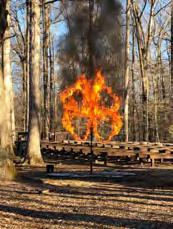

So, while white pines will take off and grow quickly, they typically conk out in the 10- to 15-year range. It’s called “white pine decline.” A Norway spruce (Picea abies) is a better choice for an evergreen screen. (I also recommend large shrubs such as viburnum to hide ugly or weird neighbors.) If you can’t get through your life without planting a white pine, place it in a full-sun, welldrained spot and hope for the best. Or move before it dies.
One of my favorite trees is sourwood (Oxydendrun arboreum), which often is sold in catalogs as “lily of the valley tree.” It has white flowers in the spring and stunning fall color. But like the white pine, it is happy only in a small portion of the state— the mountains of southeastern Kentucky. It doesn’t like heavy soil, alkaline soil or poor drainage. I’ve tried growing it in Shelby County. I can’t. It’s another tree for which you might pay dearly at a garden center for the privilege of watching it succumb to a slow death.

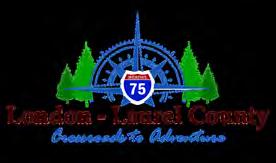

I’ve already mentioned the river birch above as better for Kentucky than the paper or white birch, but it, too, has issues and is frequently planted in the wrong place. For some reason, back in the 1980s, landscape designers “discovered” river birch with its pink, peeling bark and planted them next to every house ever built in that decade. River birch is native. River birch is hardy— extremely hardy. In fact, most of them outgrew the spaces they were allocated next to the house, towered over roofs and gutters, dropped their voluminous twigs therein, and generally became a nuisance rather than an asset.
Not to be a Negative Nelly, but I know there are many other trees you might find while shopping that should have a “buyer beware” label. A tree is a big investment in cash and time. Invest wisely this spring.

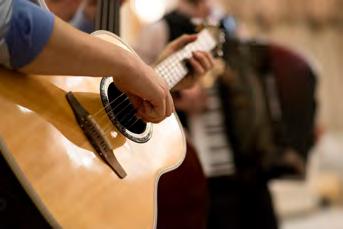
Or do what you’re told and wait to plant in the fall.




kentuckymonthly.com 61 VISITLONDONKY.COM music. hike. bike.
How do you plan the weekend? Let us make it easy for you. (606)-878-6900
run.
by Gary Garth
Going Nuclear
Irecently sat for a myocardial perfusion SPECT (single-photon emission computed tomography). In less highbrow language, that’s a nuclear cardiac imaging test which, among other things, shows how well blood is flowing through your heart and how well that heart is pumping.
For me, the test was part of a long-term maintenance checkup following a curious incident that happened about five years ago.
The test itself didn’t bother me, although the nuclear part did give me a moment of pause. I understand that nuclear medicine has become a vital and valuable tool in the health care toolbox. But I am also a Cold War baby, and the word “nuclear” ripples many memories, including backyard bomb shelters and school children crawling beneath elementary school desks, both of which are laughably weak defenses against the flash from a world-crushing nuclear strike.
On the medical front, however, nuclear is user friendly. I learned there are various methods that medical folks can use to check your heart, including the myocardial perfusion SPECT, which includes injecting a small amount of radioactive material into the bloodstream. “The nuclear test will give us better results,” Jessica, the cardiac specialist, explained cheerfully.
An appointment was made. I arrived at 6:30 a.m. as requested.
Georgia, the registration clerk, had a few questions.
“Do you have a living will?”
“Do you think I’ll need one?”
She glanced up with the no-nonsense glare that hospital administrative folks have.
“Yes. I have a living will.”
“Are you a smoker?”
“No.”
“If you’re admitted, can they tell family and friends?”
“I don’t expect to be admitted.”
Same look.
“Yes.”
“Would you like to see a pastor?”
“Now?”
“No. If you’re admitted.”
“That would be fine.”
I signed a sheath of papers and was directed to Radiology.
The waiting area was sterile and brightly lit. My wife and I soon were ushered into a small side room by Nicholas, who appeared to be in his early 30s with a trim physique, short dark hair and a no-nonsense demeanor. He introduced himself as the nuclear medicine technician. “We’ll be taking care of you today,” he said.
He got the IV successfully started on the first try, flushed it with a bit of saline solution, then pumped in a small vial of a pale solution that was numbingly cold. A tracer, he explained.
“This the radioactive stuff?” I asked, jokingly.
“Yeah. But just a little.”
I was returned to the waiting area, offered a bottle of water—which I accepted—and told it would be a 45-minute wait while the tracer did its work. Nicholas then reappeared and escorted me to a small room where Stacey, the cardiac sonographer, awaited. She directed me to a machine that resembled an open-ended coffin.
I removed my eyeglasses, wallet and car keys and was instructed to lie on my back, arms overhead. It was a tight fit.
“This will take nine minutes,” she said. The instructions were simple: Try not to move.
The room was cold. A blanket was offered, which I foolishly declined. Stacey appeared at my side, smiling. They were ready to start.
“Are you OK?”
I acknowledged that I was OK.
“Are you sure about the blanket?”
I decided I was not sure about the blanket.
One was immediately deployed, then Stacey and Nicholas disappeared inside an enclosed control panel, and the machine began to hum, occasionally rotating across my chest.
Just when I was beginning to think Stacey and Nicholas had forgotten to check the time, they reappeared and
escorted me into the adjoining room, which contained a small bed, a treadmill, an assortment of electronics and a covey of medical folks milling around. This is the stress part of the stress test. You are stripped to the waist, wired with an alarming amount of electronics, and asked to step on the treadmill for a few minutes. The procedure is simple: Pace the treadmill until told to stop, with a continuous warning, “If you have any trouble, let us know.”
At the 5-minute mark, I was told we had “about a minute to go.” This was welcome news. Just before hitting the target heart rate (140 beats per minutes for me), Nicholas, who had been flanking me throughout the test, injected another shot of the icecold tracer. There was another minute on the treadmill. I was congratulated on hitting the target rate and told to lie on the bed and rest for 60 seconds. Then, I was told to rest for 60 more seconds before being escorted next door for another 9-minute scan supervised by Stacey.
Nicholas unplugged the IV.
“That’s it,” he said.
“That’s it?”
“Yeah.”
I collected my eyeglasses, wallet and keys.
“What’d you find out?” I asked, knowing no answer was coming.
“We only have the raw data,” Nicholas said, repeating an answer he undoubtedly gives multiple times daily. “They’ll let you know.” •
Test results “looked good,” according to Jessica, which were the results I expected but for which I was also thankful.
Take care of yourself. Be attentive. That twinge you felt while hiking to the trout stream, or pitching a backcountry camp, or when your heart rate jumped to 140 for no apparent reason … it was probably nothing. But don’t bet your life on it.
field notes 62 KENTUCKY MONTHLY MARCH 2023
• •
Readers may contact Gary Garth at editor@kentuckymonthly.com
Ongoing Rounding the Circle Exhibit, Speed Art Museum, Louisville, through Aug. 8, 502.634.2700
5
Ongoing Kentucky
Women: Helen LaFrance, Speed Art Museum, Louisville, through April 29, 502.634.2700
6 Tootsie, Carson Center, Paducah, 270.908.2037
19
20
Peking Acrobats, Featuring The Shanghai Circus, Carson Center, Paducah, 270.908.2037

26 Amy Grant in Concert, Preston Arts Center, Henderson, 270.826.5916
27
Ongoing Crazy Quilt Mania, Kentucky Museum, Bowling Green, through June 30, 270.745.2592
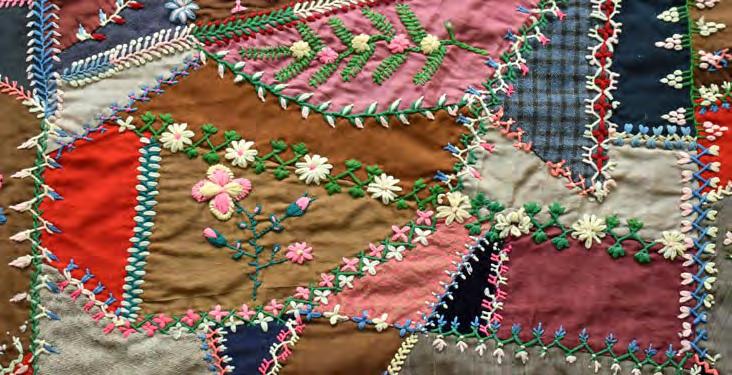
1
Jeff Dunham: Still Not Canceled KFC Yum! Center, Louisville, 502.690.9000
2 Clue Barn Lot Theater, Edmonton, through March 5, 270.432.2276
3
4
Peter and the Starcatcher, Leeds Center for the Arts, Winchester, through March 5, 859.744.6437
7 Kingdom Choir in Concert, Glema Mahr Center for the Arts, Madisonville, 270.824.8650
8
9 Blake Shelton in Concert, KFC Yum! Center, Louisville, 502.690.9000
17
11
The Kentucky Crafted Market, Kentucky Horse Park, Lexington, through March 12, 502.892.3126 14

15 Family Fun and Learning Night, The Carnegie Center for Literacy and Learning, Lexington, 859.254.4175
16 Earls of Leicester in Concert, Lyric Theatre and Cultural Arts Center, Lexington, 859.280.2218
21
Celebrating Famed
Historian Tom Owen, Frazier History Museum, Louisville, 502.753.5663
Our Planet Live in Concert, EKU Center for the Arts, Richmond, 859.622.7469

Mt. Sterling Merchants Spring Open House downtown Mt. Sterling, through March 18, 859.498.8732
18
From Nashville with Strings Alhambra Theatre, Hopkinsville, 270.887.4295 22
23
Kentucky Writers Hall of Fame Induction, Kentucky Theatre, Lexington, 859.254.4175
24
Southern Kentucky Book Fest, Knicely Center, Bowling Green, through March 25, 270.745.4502
31
Lexington Humane Society Presents Tails and Ales Hilton Lexington, 859.233.0044
Men are From Mars, SKyPAC, Bowling Green, 270.904.1880 For
25 Star Party Mahr Park Arboretum, Madisonville, 270.584.9017
Ongoing West of Ninth: Race, Reckoning and Reconciliation, Frazier History Museum, Louisville through Sept. 1, 502.753.5663
SUNDAY MONDAY TUESDAY WEDNESDAY THURSDAY FRIDAY SATURDAY
MARCH 2023
a guide to Kentucky’s most interesting events
calendar
a more extensive listing of events, visit kentuckymonthly.com.
Crazy Quilt Mania
kentuckymonthly.com 63
<<< 28
<<<
<<<
25th Approaching Soon vested interest
Kentucky Monthly soon will celebrate its 25th anniversary.
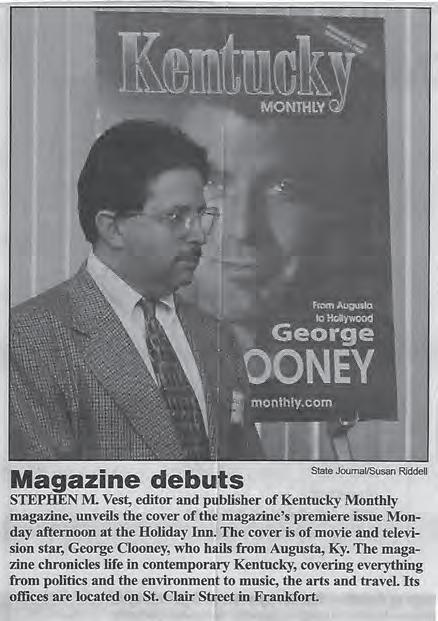
Our offices opened in June 1998, and Gov. Paul Patton declared August 17, 1998, Kentucky Monthly Magazine Day in the Commonwealth. There have been 266 issues since, and we’ve tried to live up to the charges in Patton’s proclamation:
WHEREAS, Kentucky life is a rich tapestry of events and achievements in sports, politics, literature, the arts, education, and economics in communities, both rural and urban; and
WHEREAS, Kentucky is the birthplace and home to many celebrities in various walks of life whose fame and success are derived from their Kentucky heritage; and
WHEREAS, the people of Kentucky are proud of their state and enjoy publications that reflect the full breadth and sophistication of the Commonwealth’s unique culture, and
WHEREAS, Kentucky Monthly Magazine will convey this culture and heritage while providing a showplace for advertising Kentucky’s many quality products, services, and tourist attractions,
NOW, THEREFORE, I, PAUL E. PATTON, Governor of the Commonwealth of Kentucky, do hereby proclaim August 17, 1998, as
KENTUCKY MONTHLY DAY.
That night, we went to Lebanon Junction to watch the September issue roll off the press in time for a 10-day stint manning a booth at the Kentucky State Fair, where we handed out 18,000 copies. We hand delivered the rest.
In celebration, we plan to recreate part of that experience with you. No, we’re not asking you to pack your car with magazines and drive the curvy rural roads and city streets as we did. What we are asking is for you to help us identify 25 places or things in the Commonwealth you’ve always wanted to experience, and we’re going to come and do them with you.
For example, what if we met at the Kentucky Gateway Museum in Maysville for a guided tour of Kay Browning’s miniature dollhouse collection, visited the pioneer cemetery and the Pogue Bourbon exhibit, and then traveled down river to Augusta to enjoy a late lunch at the Beehive Tavern? Maybe, Nick and Nina Clooney (two of
our earliest subscribers) will join us for a toast.
Or what if we went to Paducah for a behind-the-scenes tour at the International Quilt Museum, browsed the Lower Town shops, and enjoyed a sip at Purple Toad Winery and dinner at Sarah Bradley’s Freight House?
Think of this as an opportunity and remember of what Kentuckian Abraham Lincoln said: “Genius disdains a beaten path. It seeks regions hitherto unexplored.”
So, we’ll reach out to our friends, and you send us your suggestions. The goal is to visit each corner of Kentucky, so that you can experience what we have. Please email your ideas to steve@kentuckymonthly.com.
In May 2024, we’ll offer an out-of-state trip, but most of this celebration will be here at home. We’ll meet local celebrities, see some oddities, and see our Commonwealth in all its complexities.
Big “E” Debate Continues
For those following the discussion over capitalizing Eastern Kentucky, the big E (which reminds me of Owensboro’s Executive Inn) is winning, and the delightful letters from Gayle Deaton continue:
No matter how this goes, my friend, I feel blessed by your approach in your column (February 2023). My big brother, Maco, who lives in South Carolina, texted me and was excited after getting his magazine. I love anything that brightens his days. Somehow, I overlooked your postscript about Jerry Deaton. Maco called it to my attention. We assume you meant the young’un, we’ve always known as Bucky.
In 1972, fresh from a three-month college adventure in Long Beach, California, I learned the school wasn’t accredited.
I returned to Jackson and became his dad’s secretary at our new nursing home. Bucky and his beautiful sister Leah were about 9 and 10 (or so), and I loved it whenever they were in the office. Talk about two live wires; but they were as charming and fun as they were mischievous.
To answer your question, Bucky and I are around 4th or 5th cousins. So, we’re pretty close kin by Breathitt County standards!
Blessings to you all.
Gayle Deaton
Kwiz Answers: 1. B. Eaves, who began his career at Lexington’s WKYT, played in the state golf tournament in 1990 and was named Mr. South Hopkins his senior year; 2. C. The Blue Devils and the Generals; 3. C. The Valkyries won championships in 1976, 2002-04, ’21-’22; 4. A. Boone became a colonel 16 years before Kentucky statehood. Gov. Isaac Shelby commissioned the first “Kentucky Colonel” Charles Stewart Todd, his son-in-law, in 1815; 5. C. Lair (1894-1985), a the leading authority on folk music; 6. B. Collins was the first woman to hold the governor’s office; 7. C. Robinson began his baseball career at Camp Breckinridge in Morganfield; 8. C. While it was in what is now Clark County, the exact site of the village is unknown; 9. Yoakam was born in Pikeville but grew up in Columbus, Ohio, one of the northern cities served by Route 23; 10. A. Hubbard wrote or produced 92 films between 1917-43, including Wings, starring Clara Bow, which won for best picture in 1927.
64 KENTUCKY MONTHLY MARCH 2023
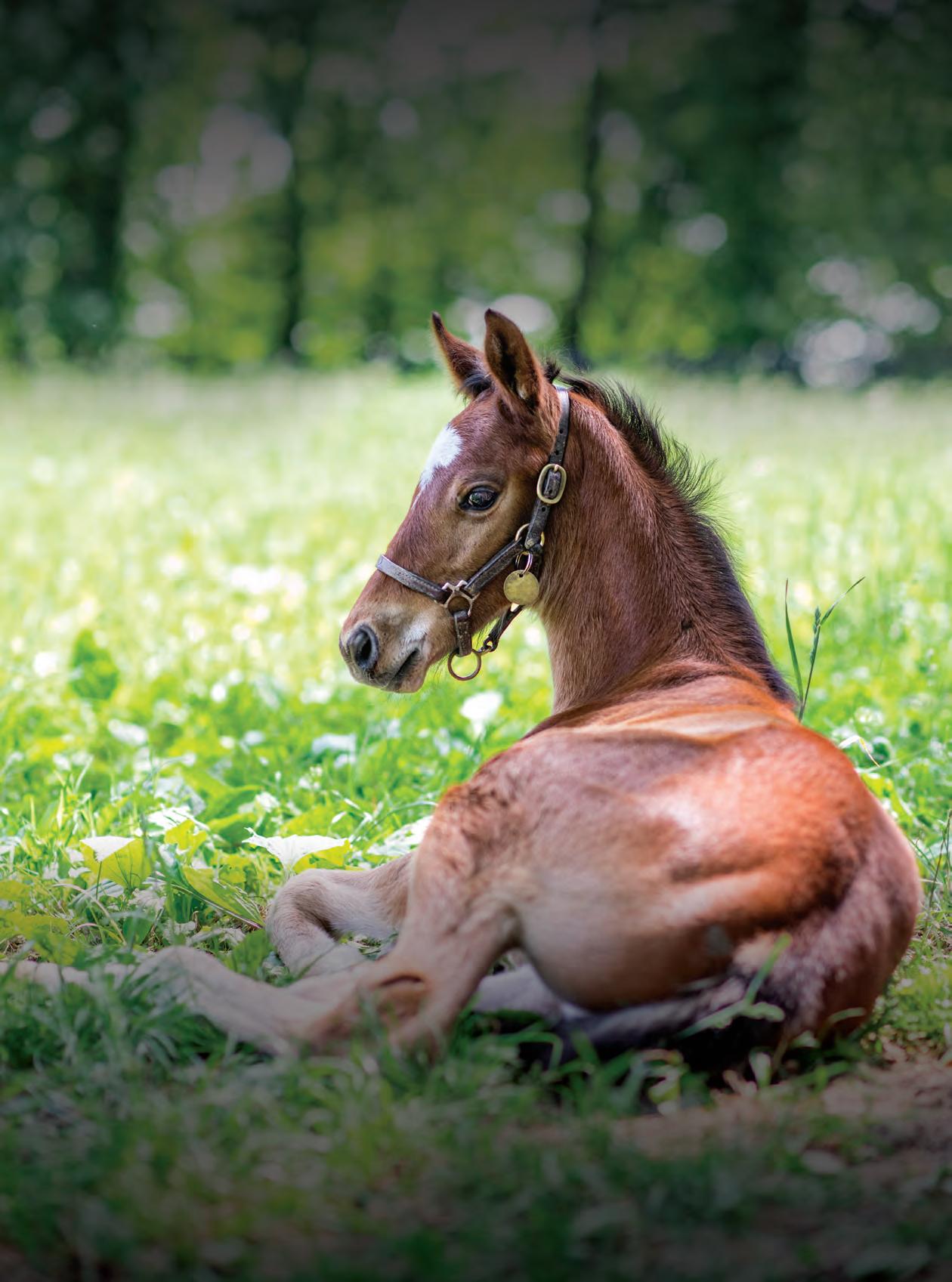
A park for every passion



Whether you’re looking to rev up or wind down, we’ve got a place just for you. Nestled in some of the state’s most beautiful settings, Kentucky State Parks offer a wide range of activities – from outdoor adventures to nature escapes – and accommodations from rustic campsites and cozy cabins to resort park lodges. Plus, 13 nationally recognized state park golf courses get you out on the links to soak up incredible views.
Book your spring getaway at parks.ky.gov!





























































































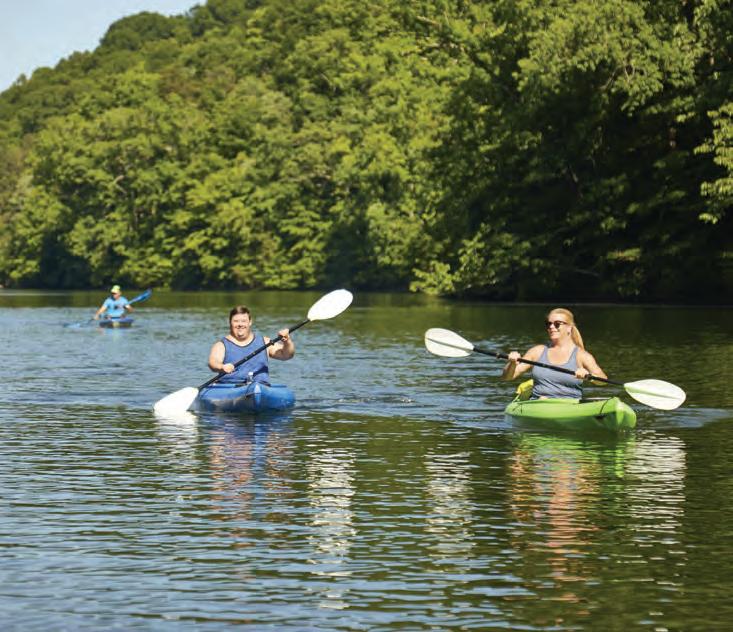
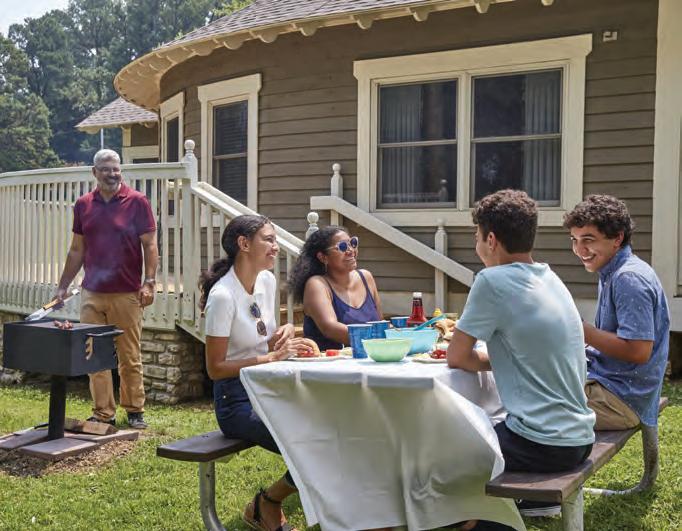
















































































 BY ARTHUR M c DADE
BY ARTHUR M c DADE






























































































































































































 By Bobbi Dawn Rightmyer, Harrodsburg
By Bobbi Dawn Rightmyer, Harrodsburg
















































































































